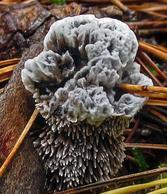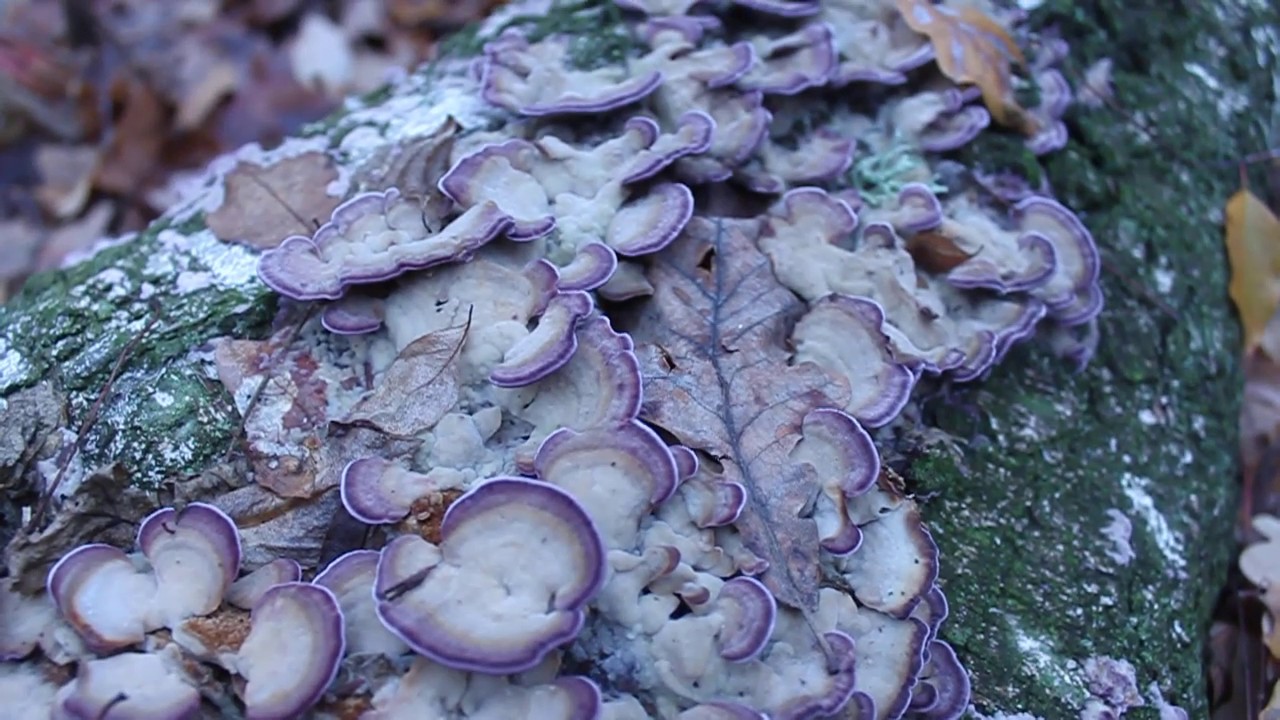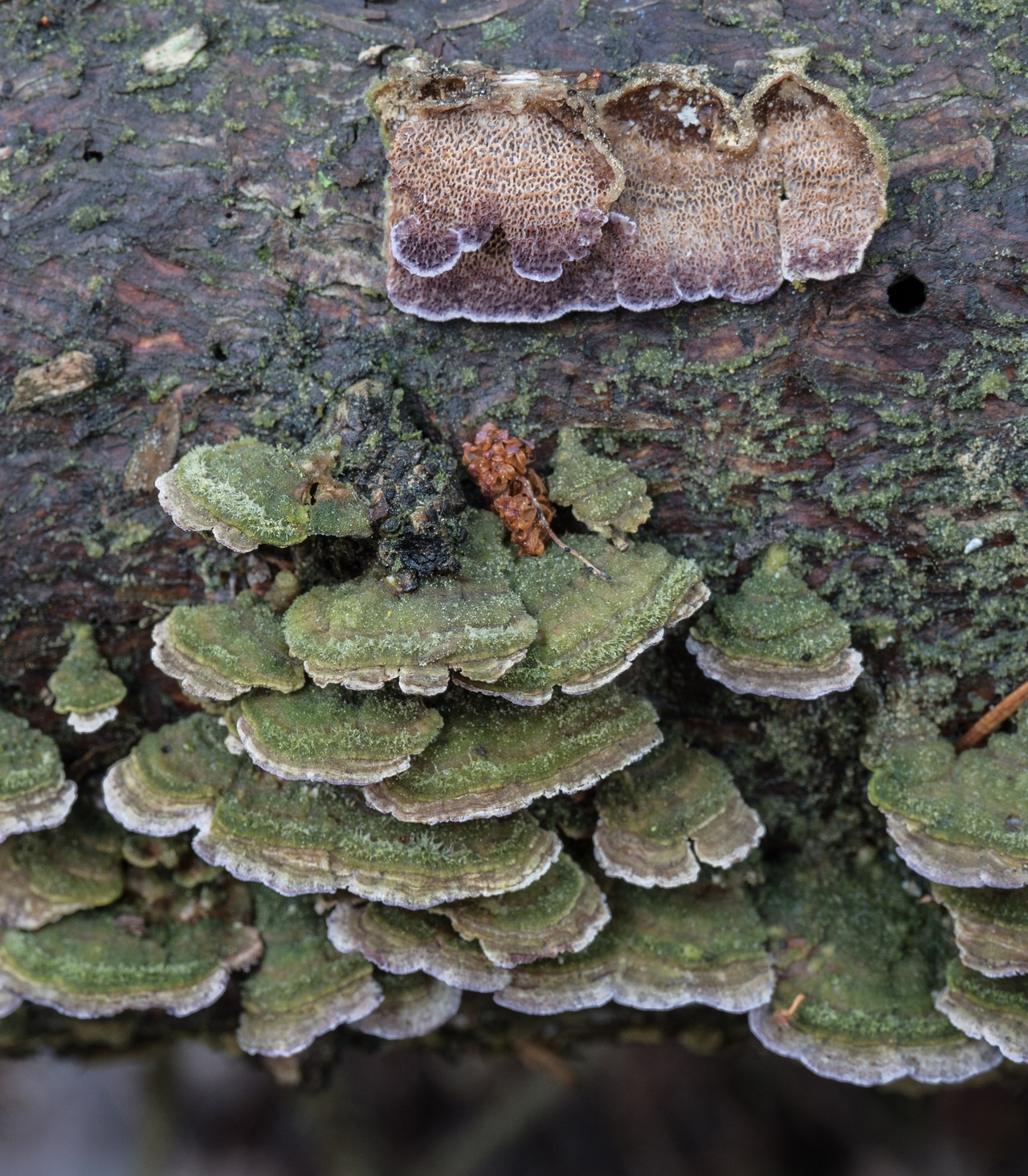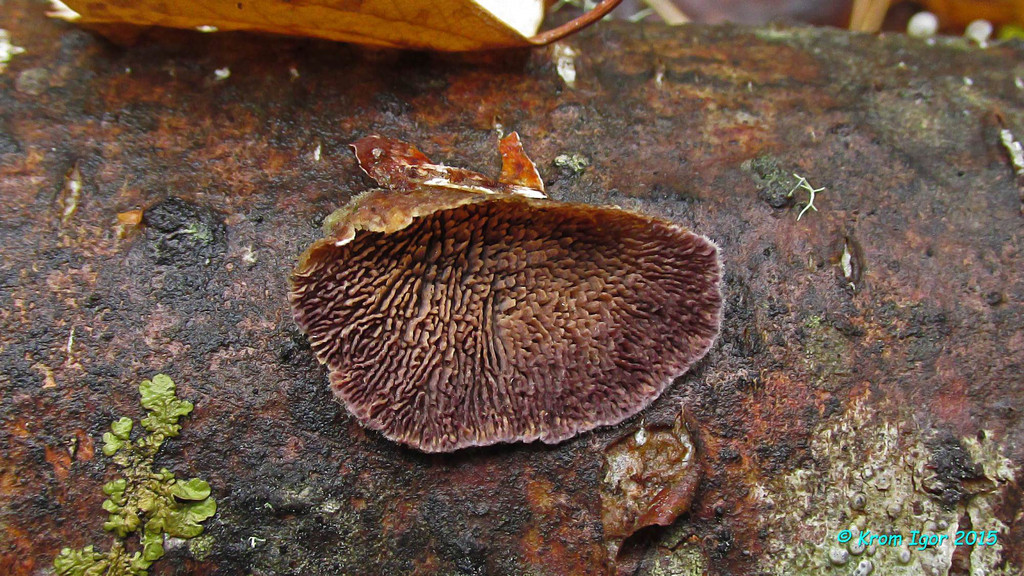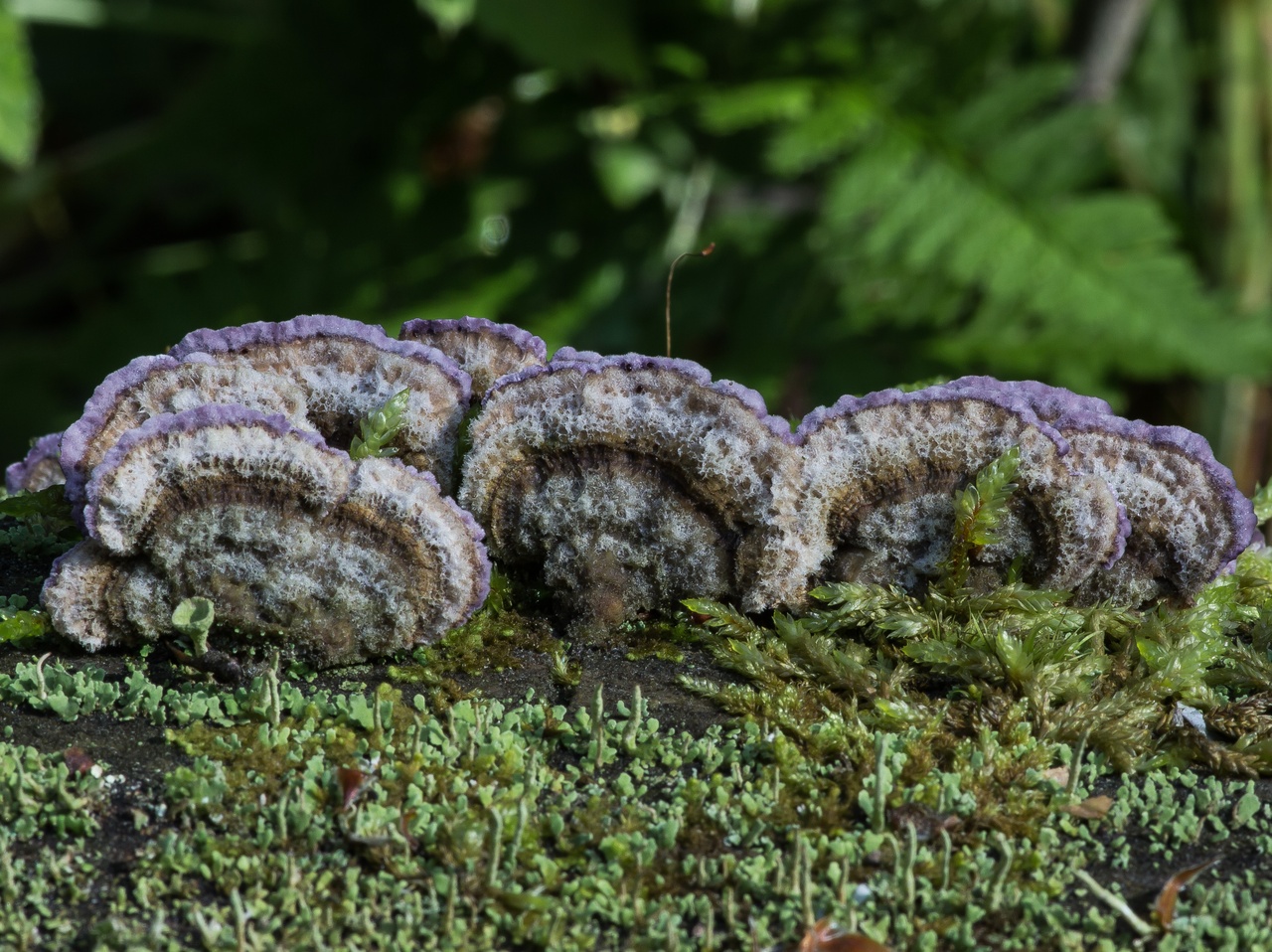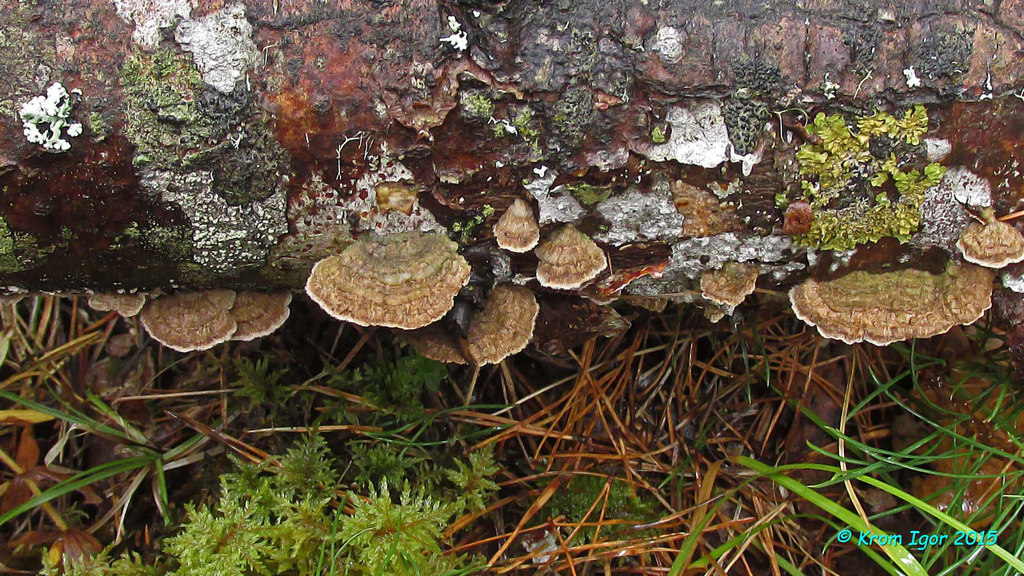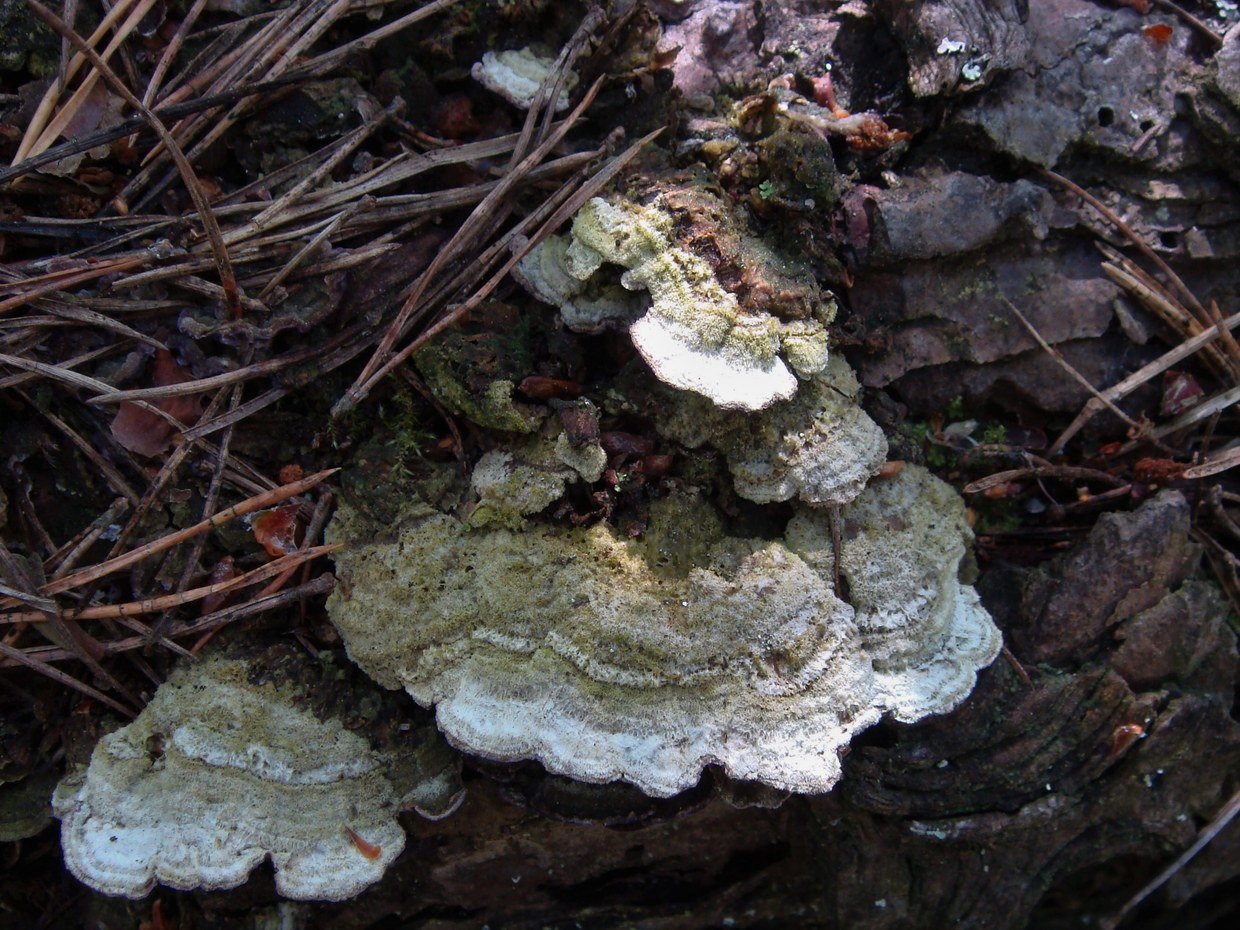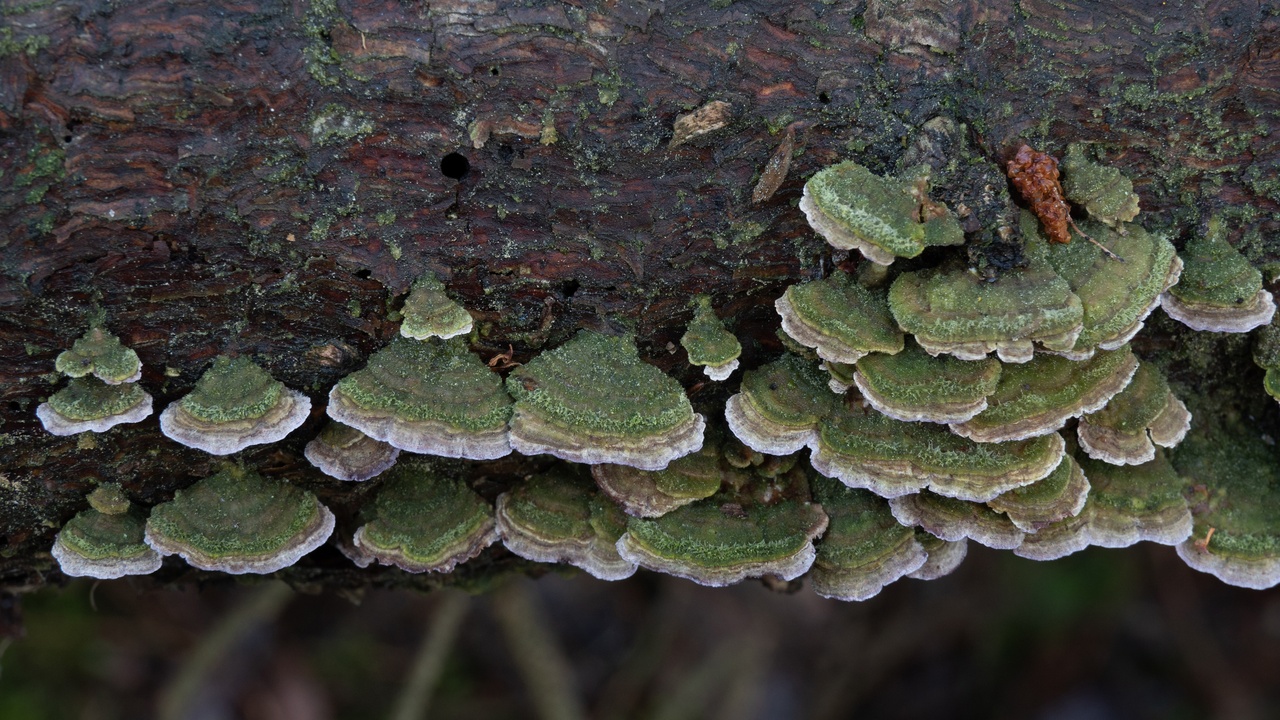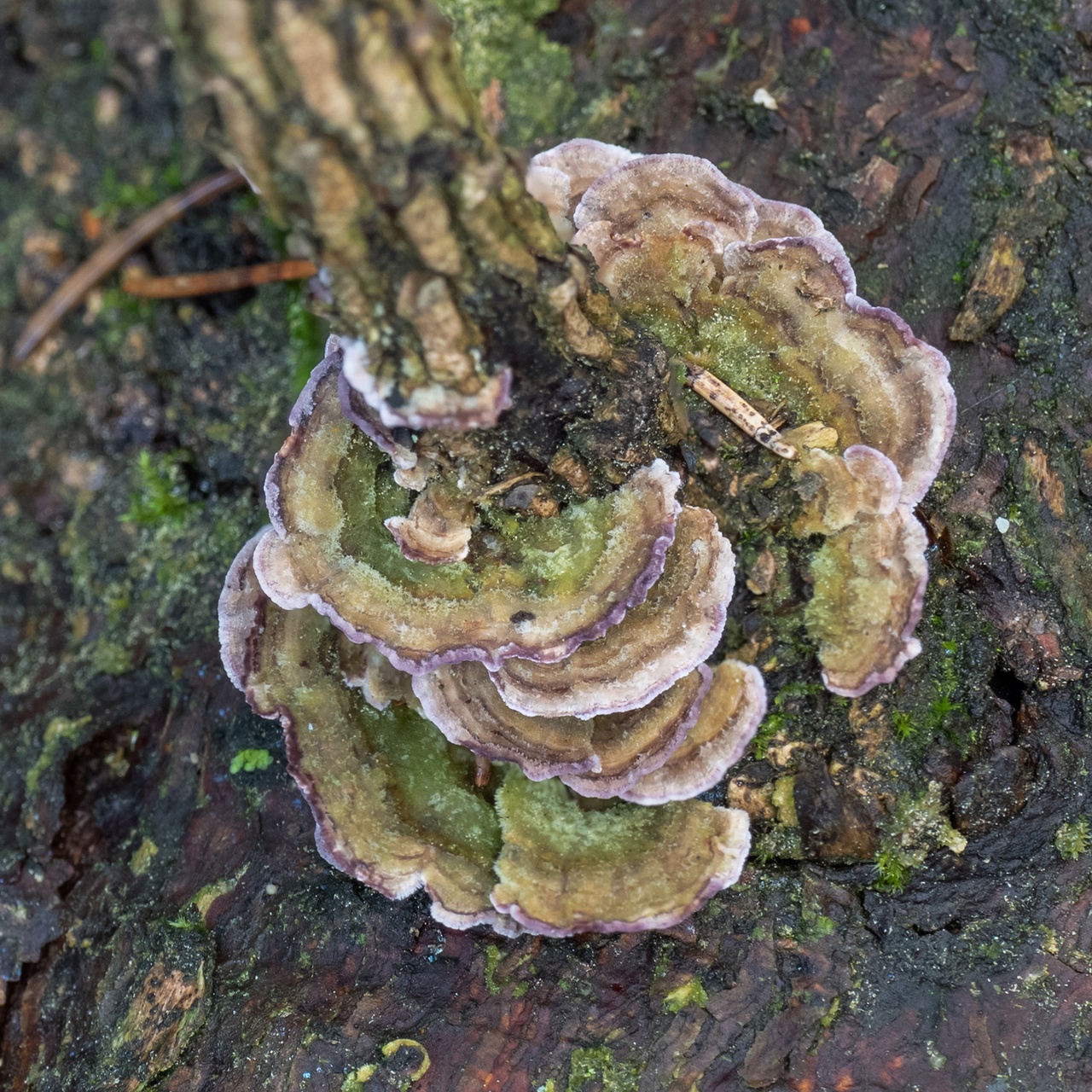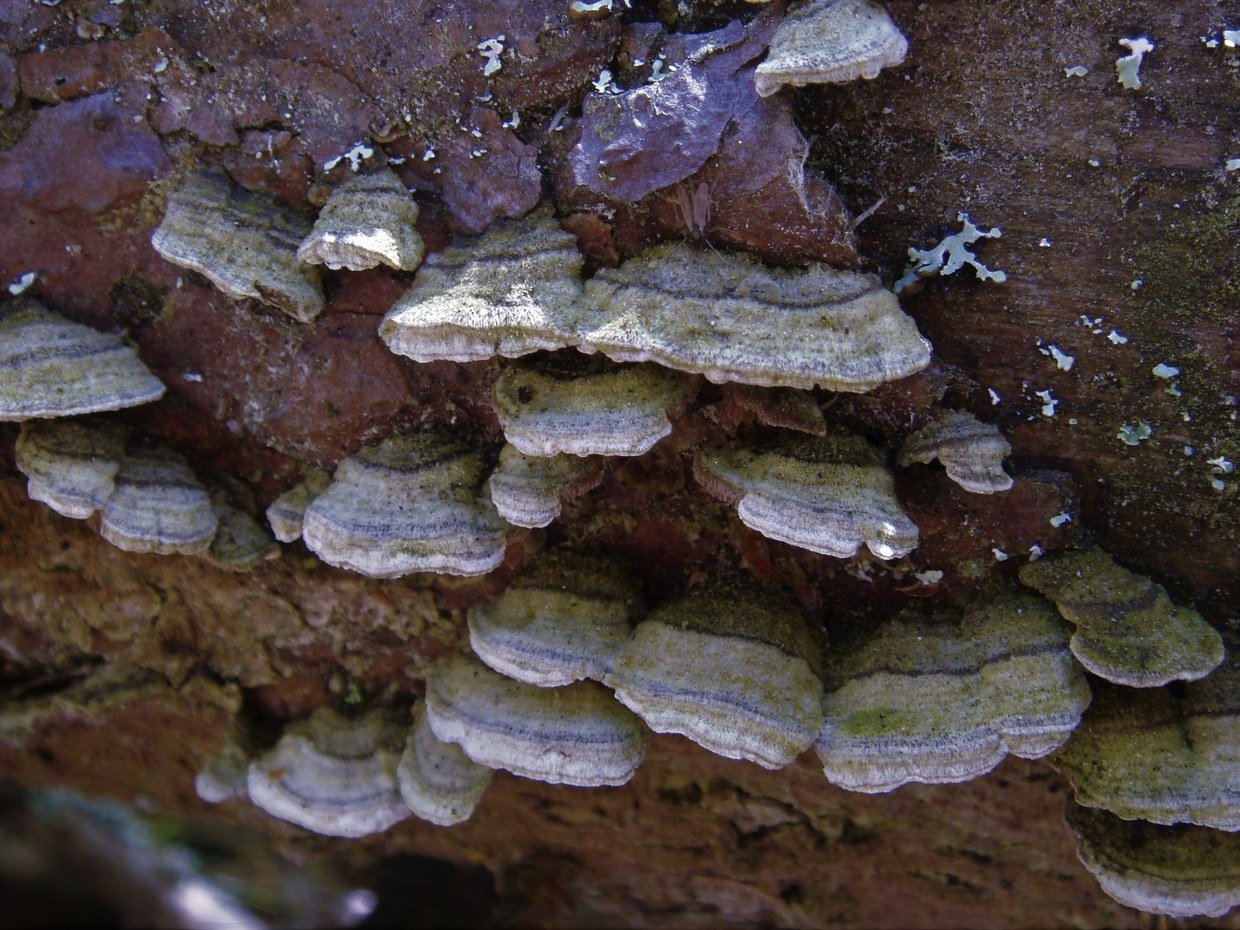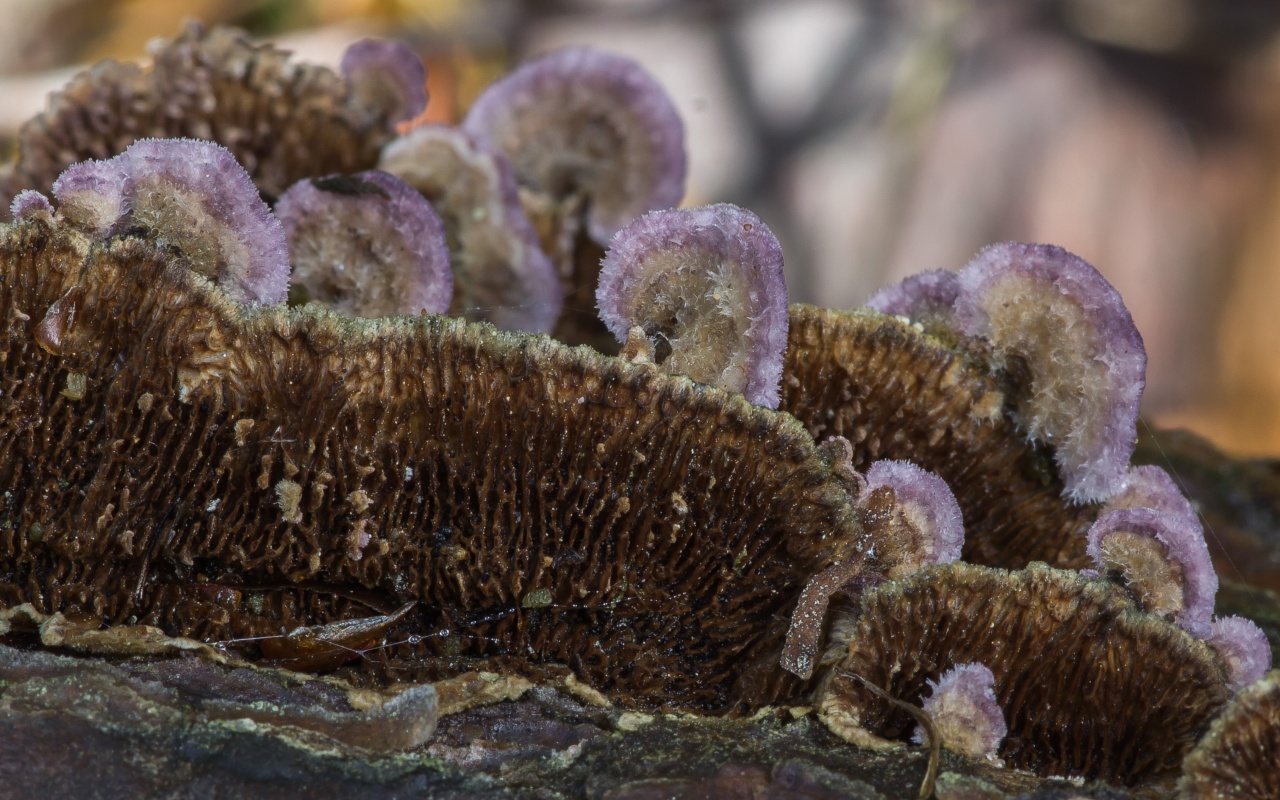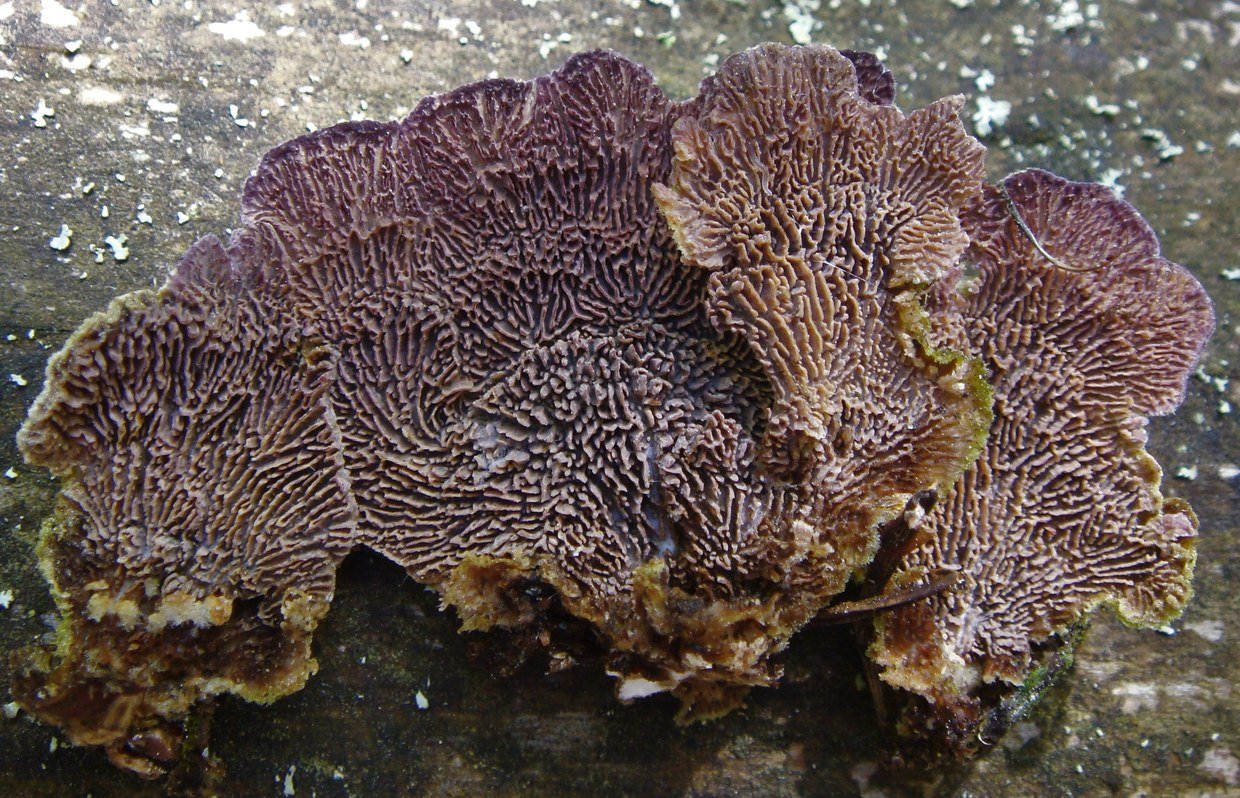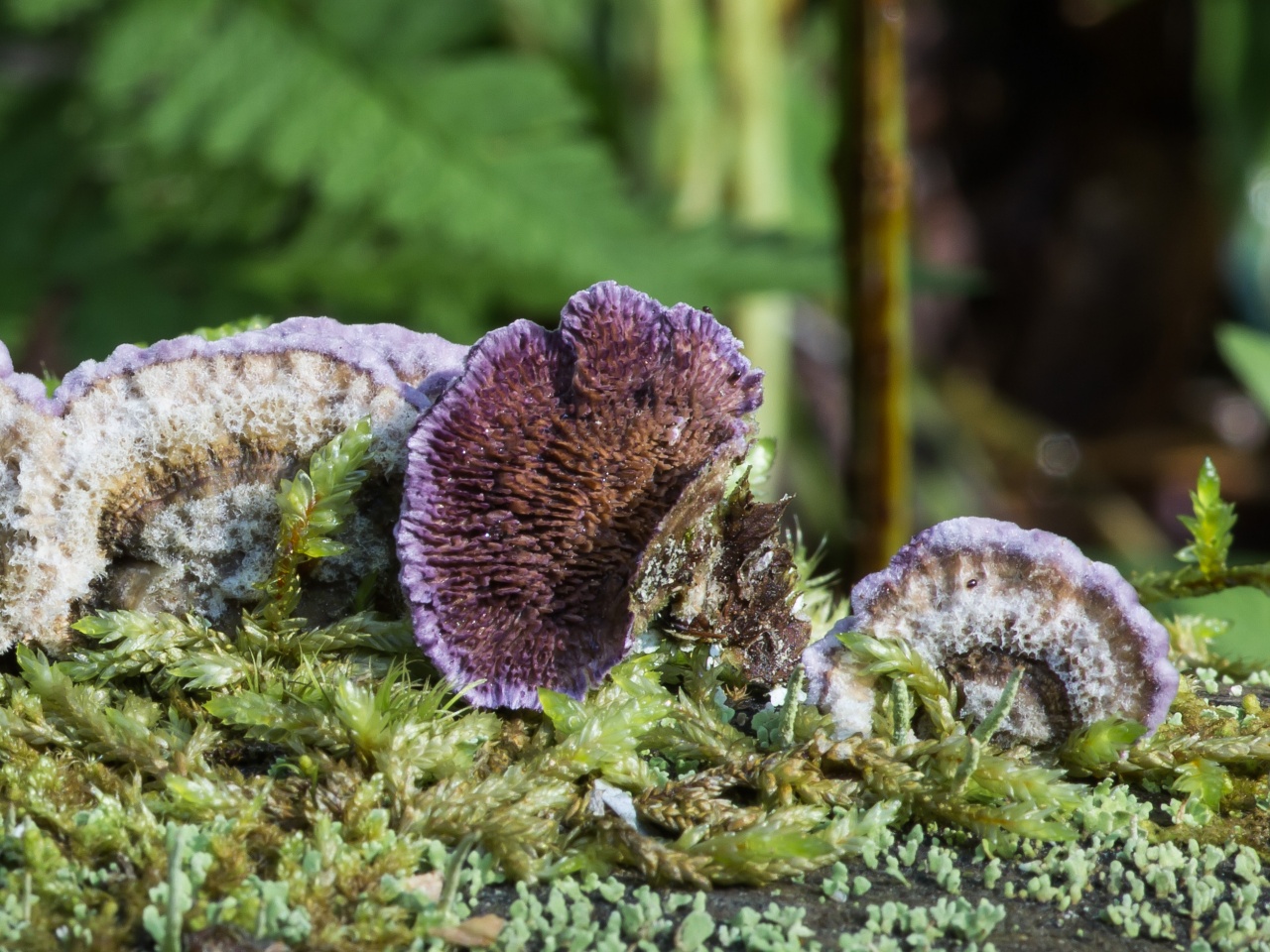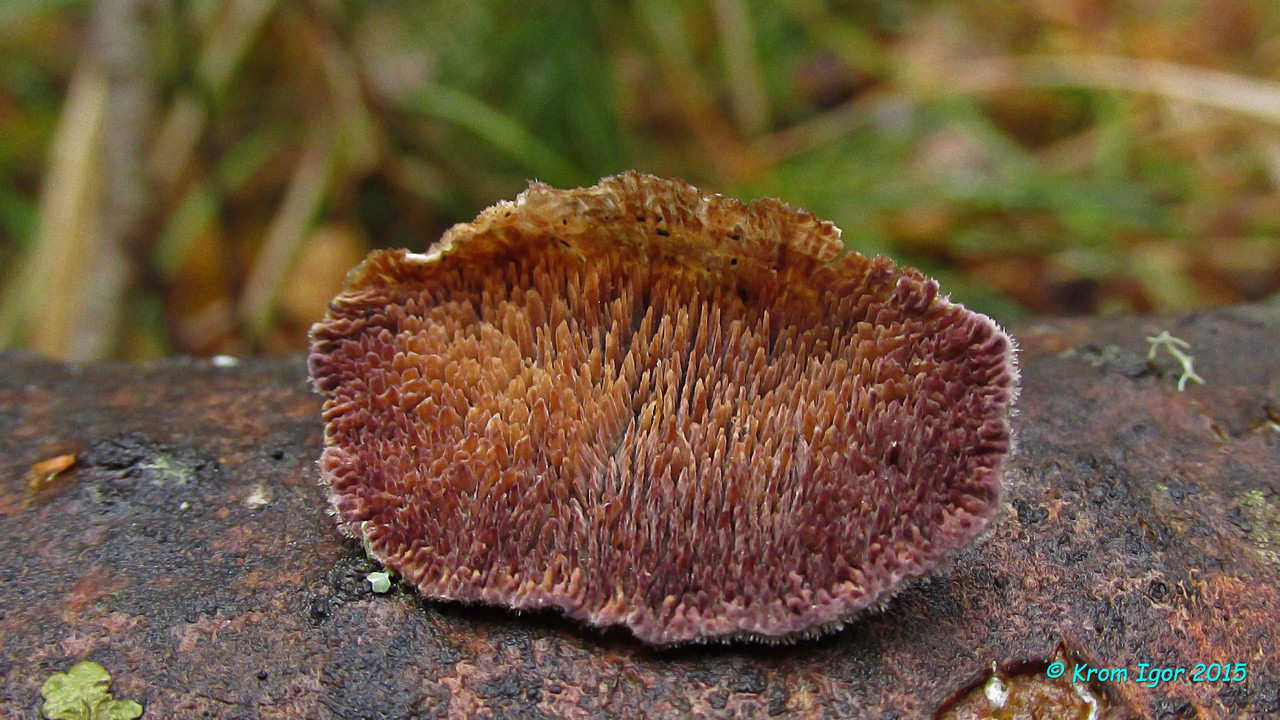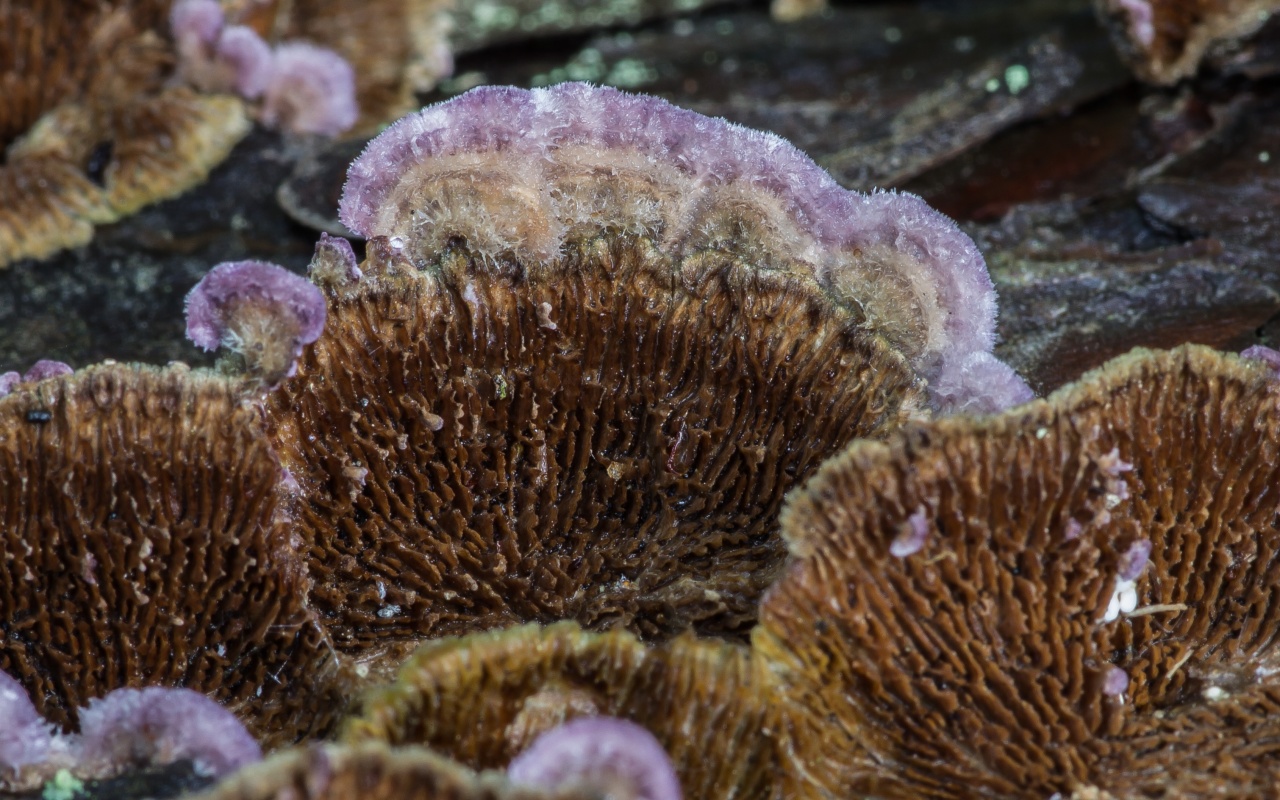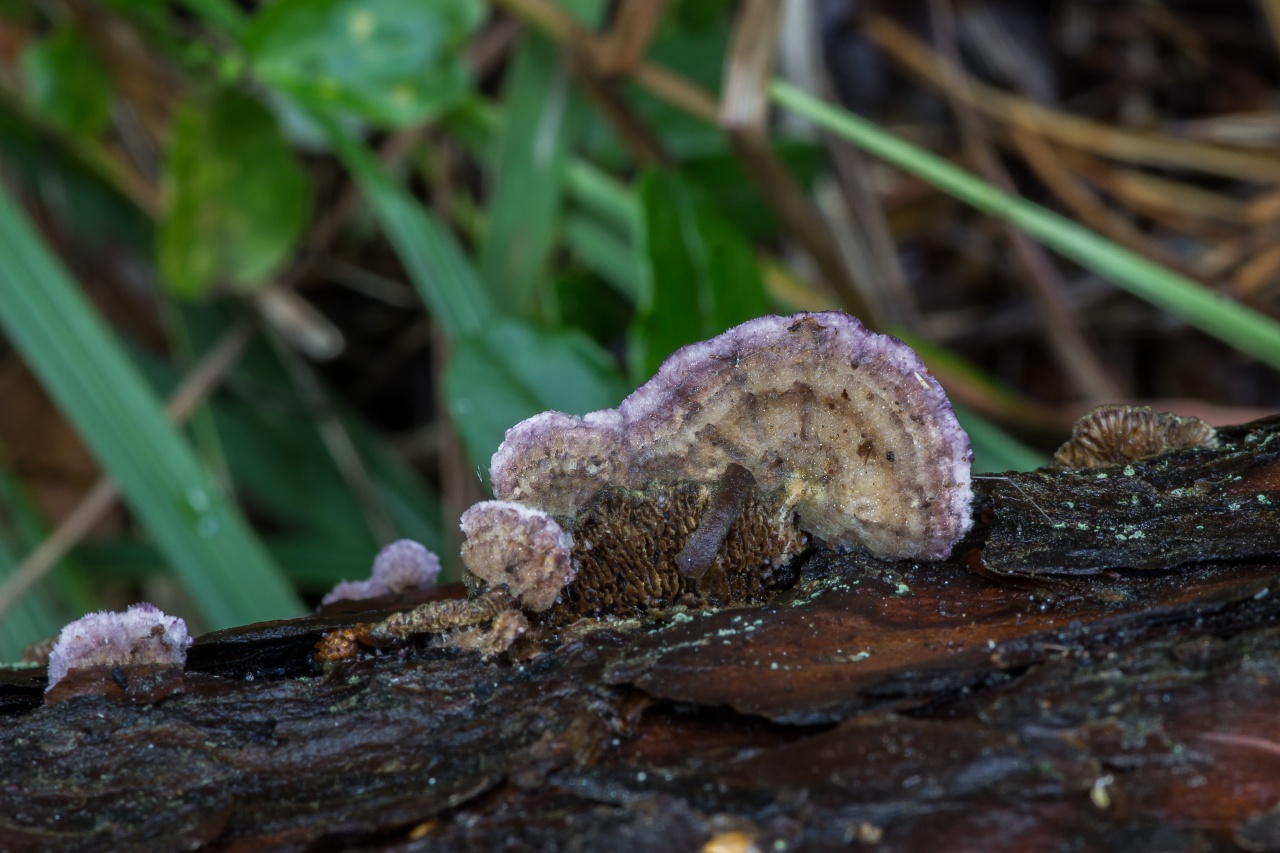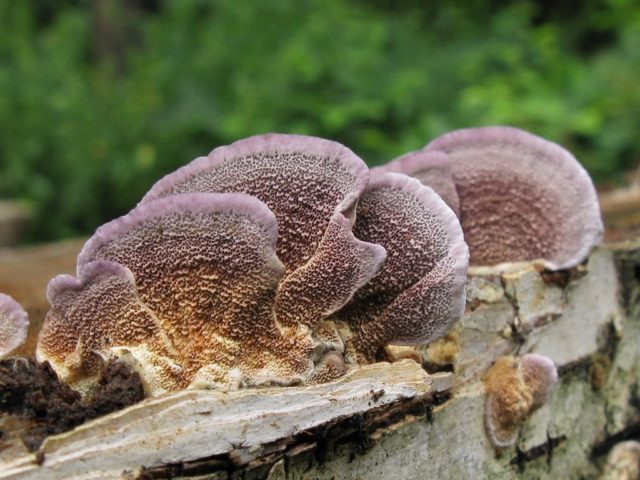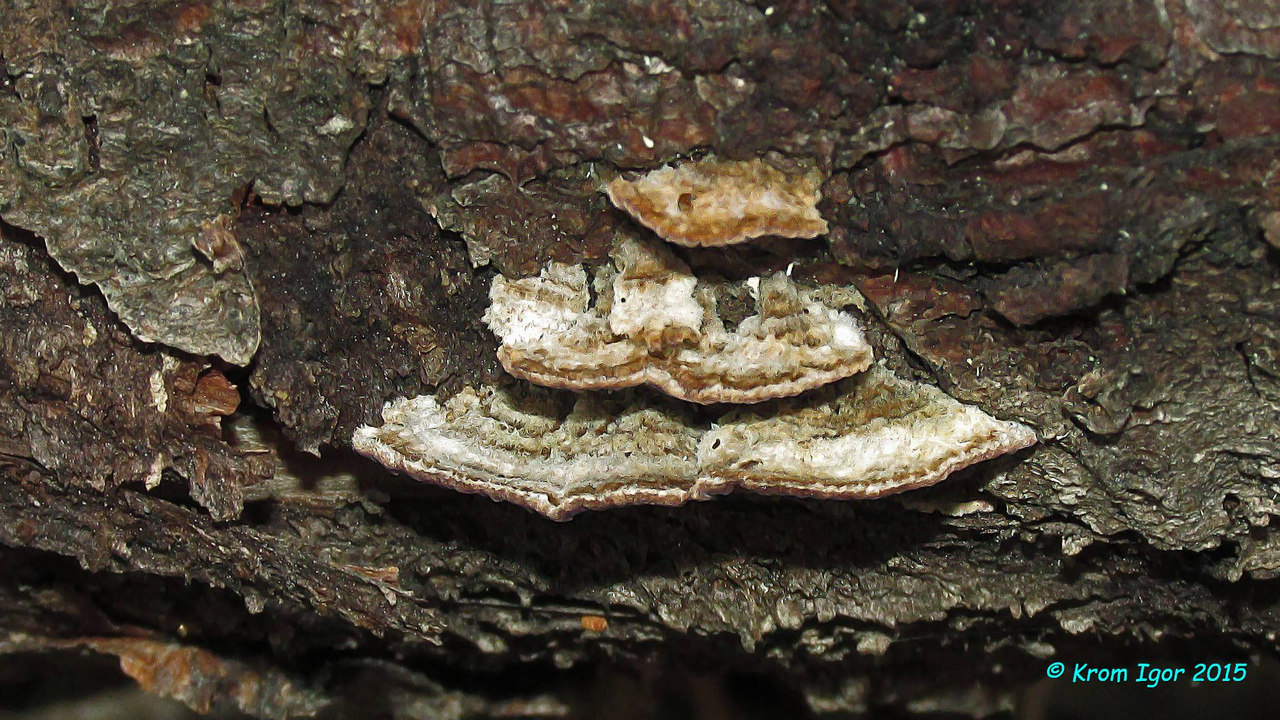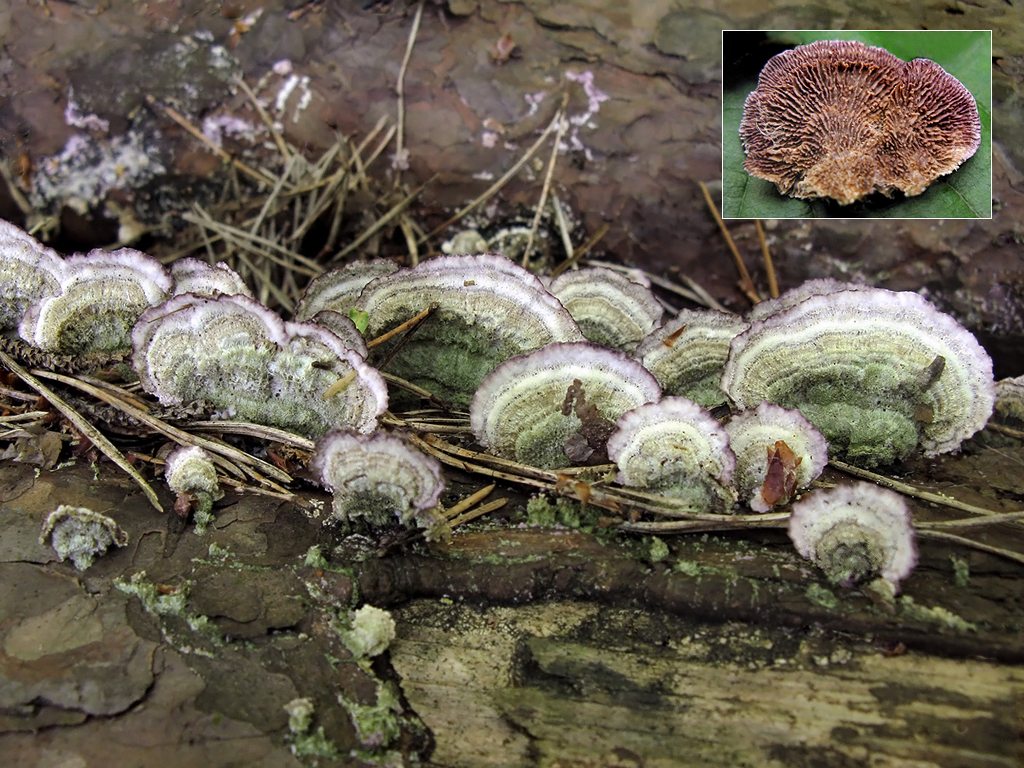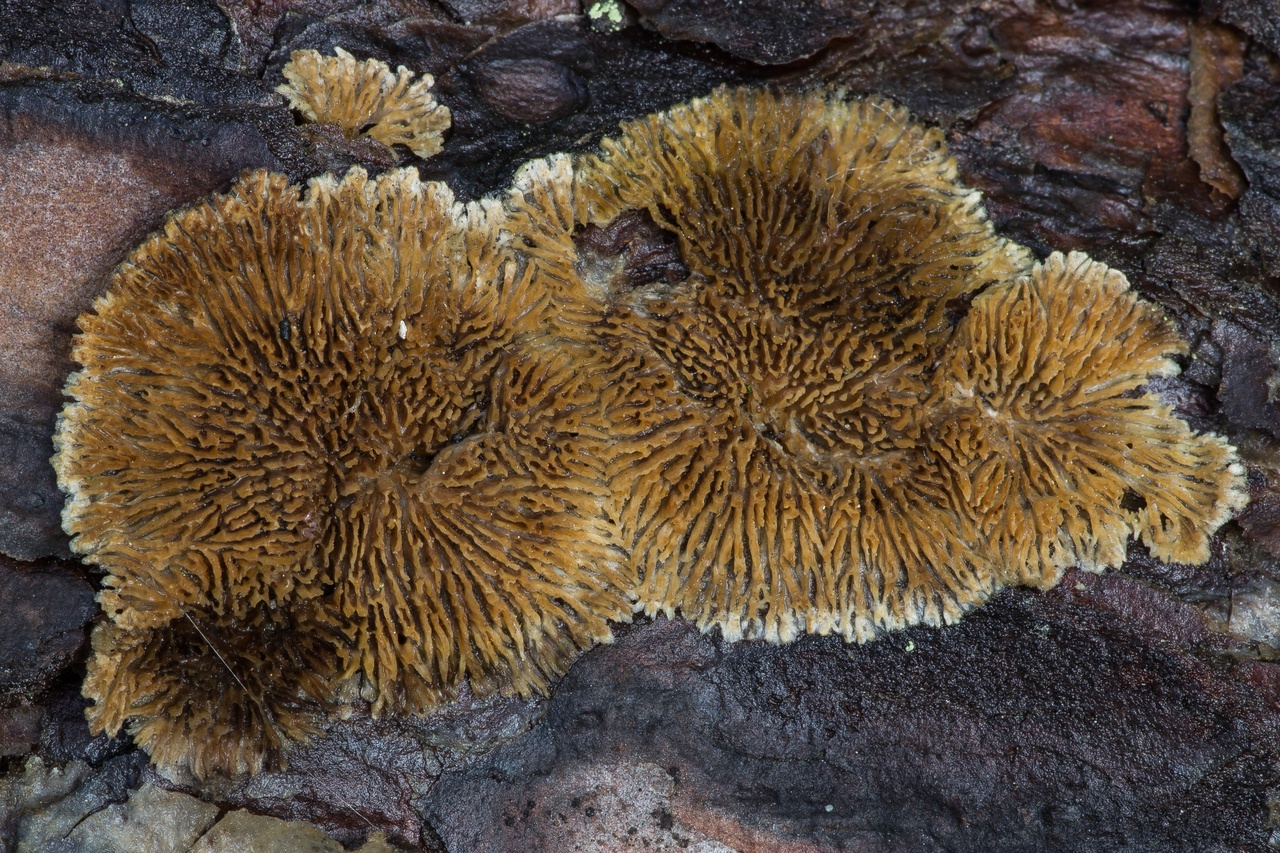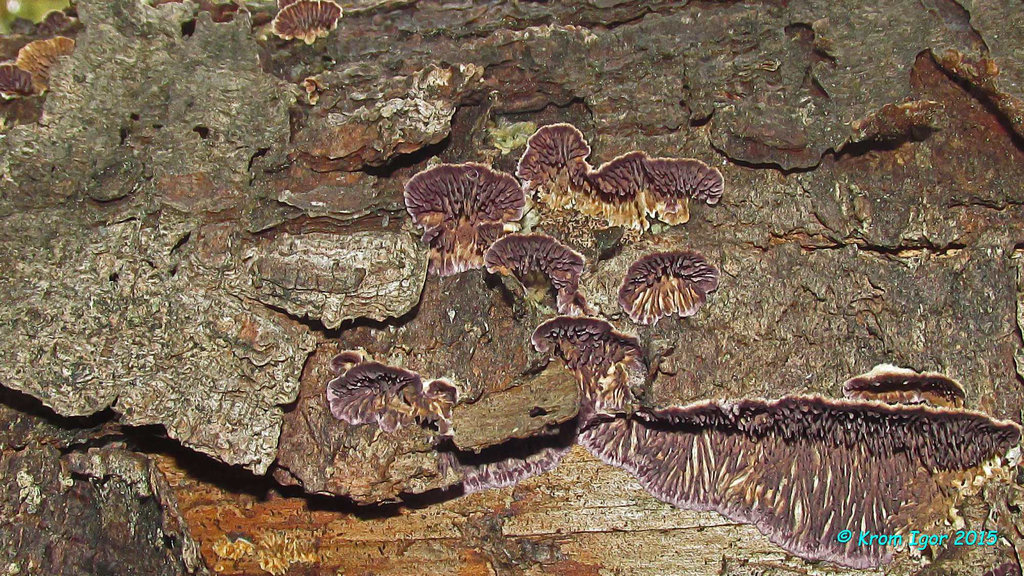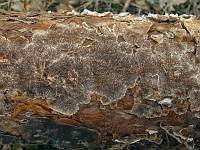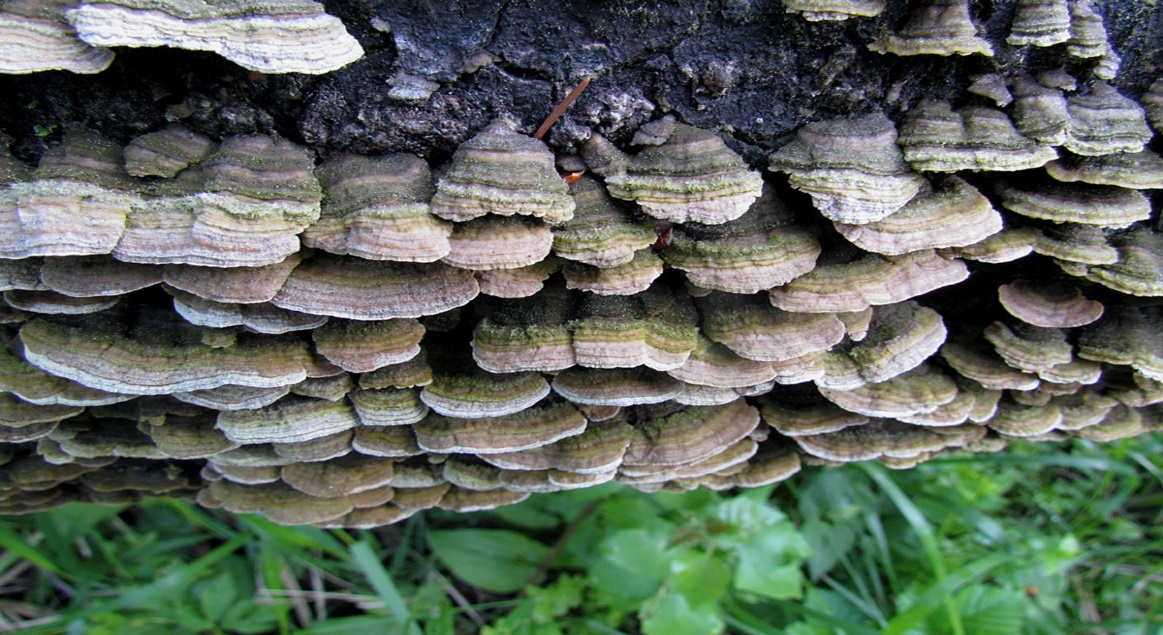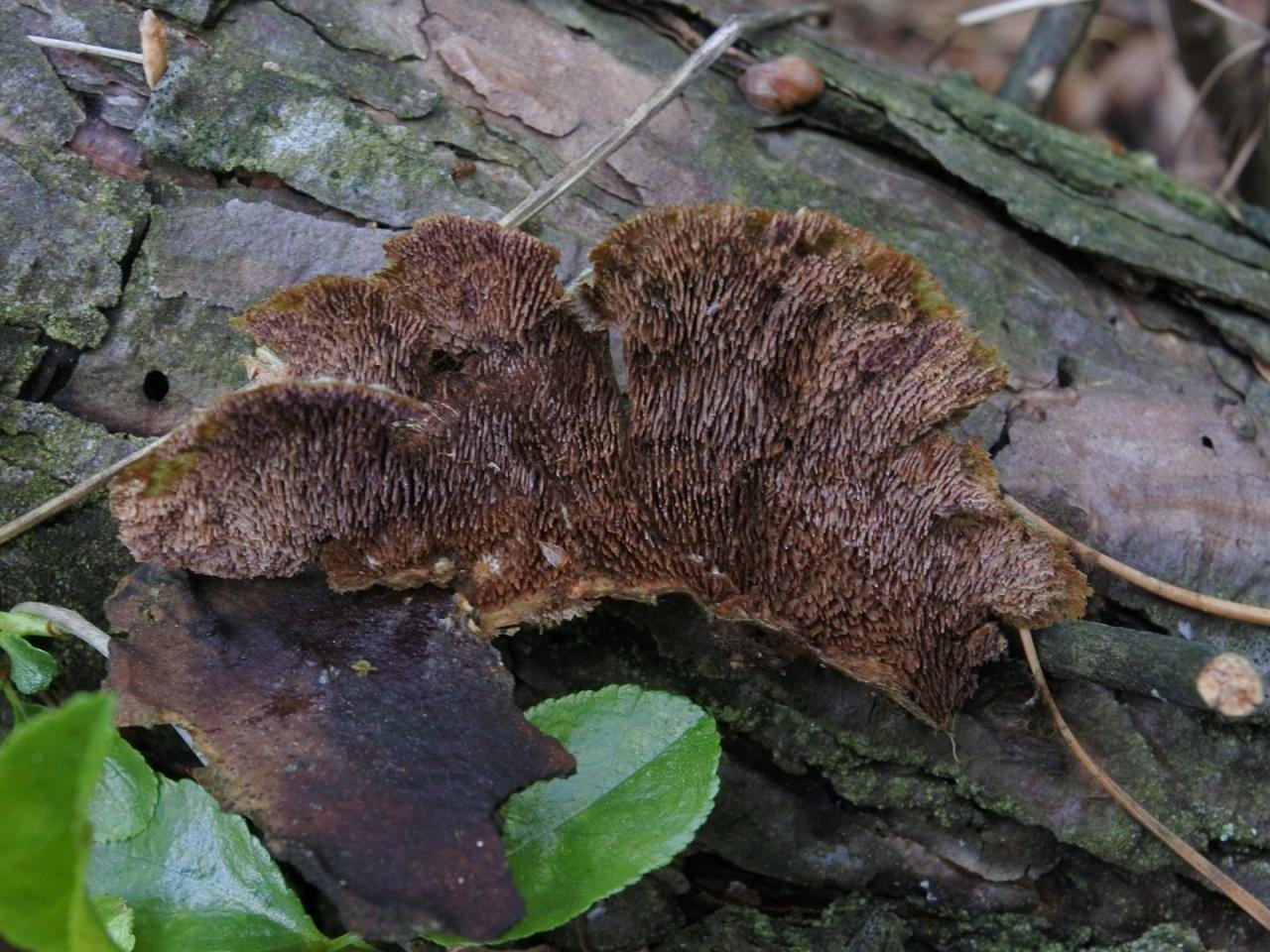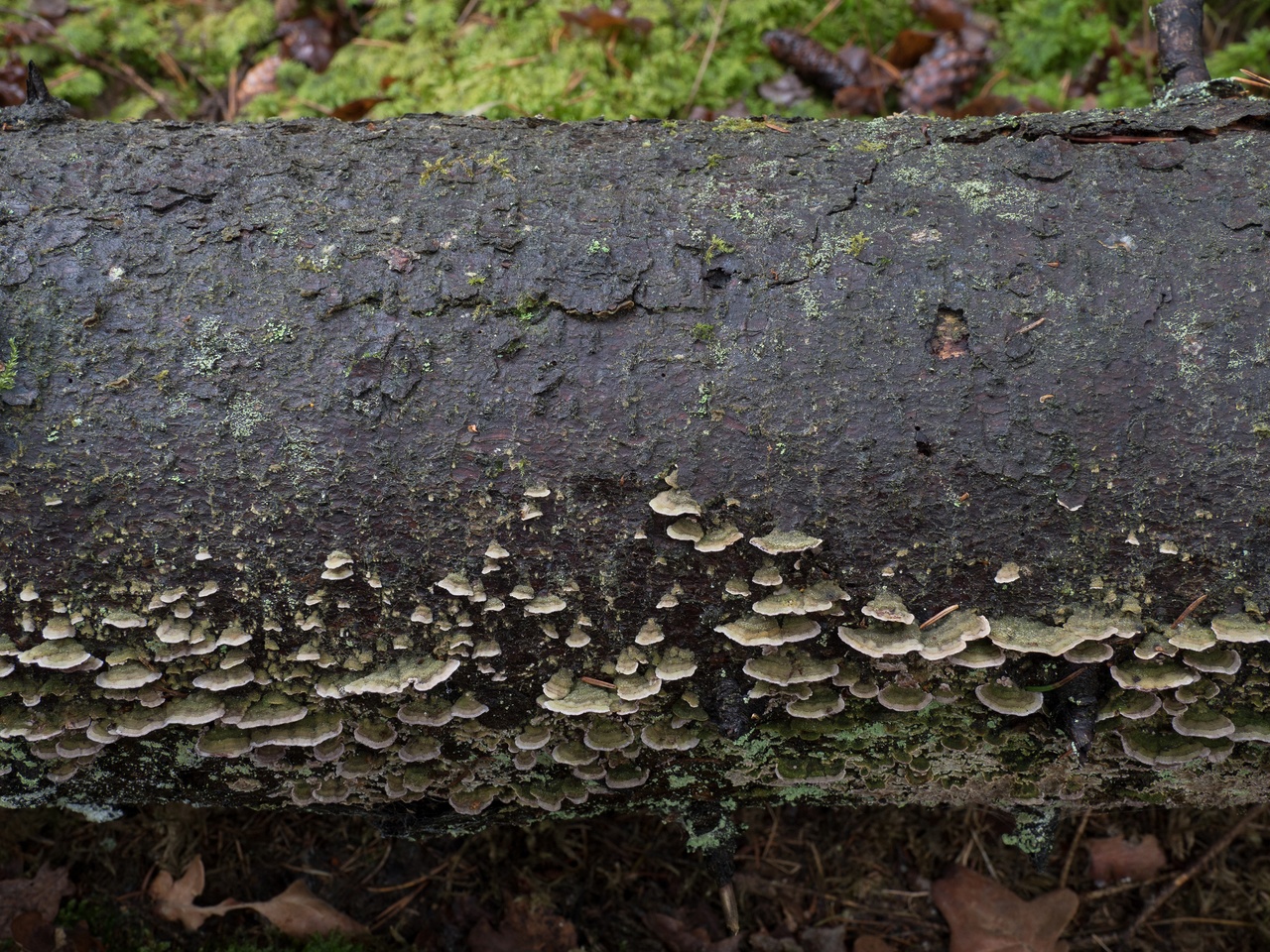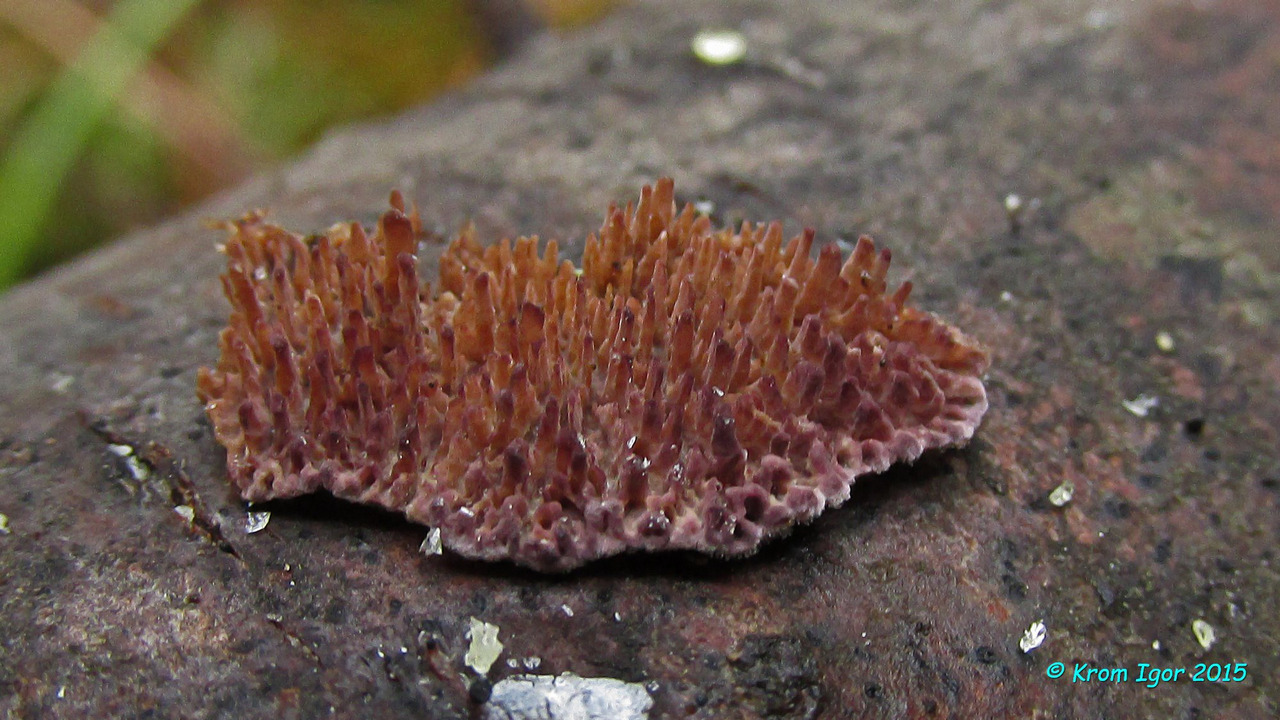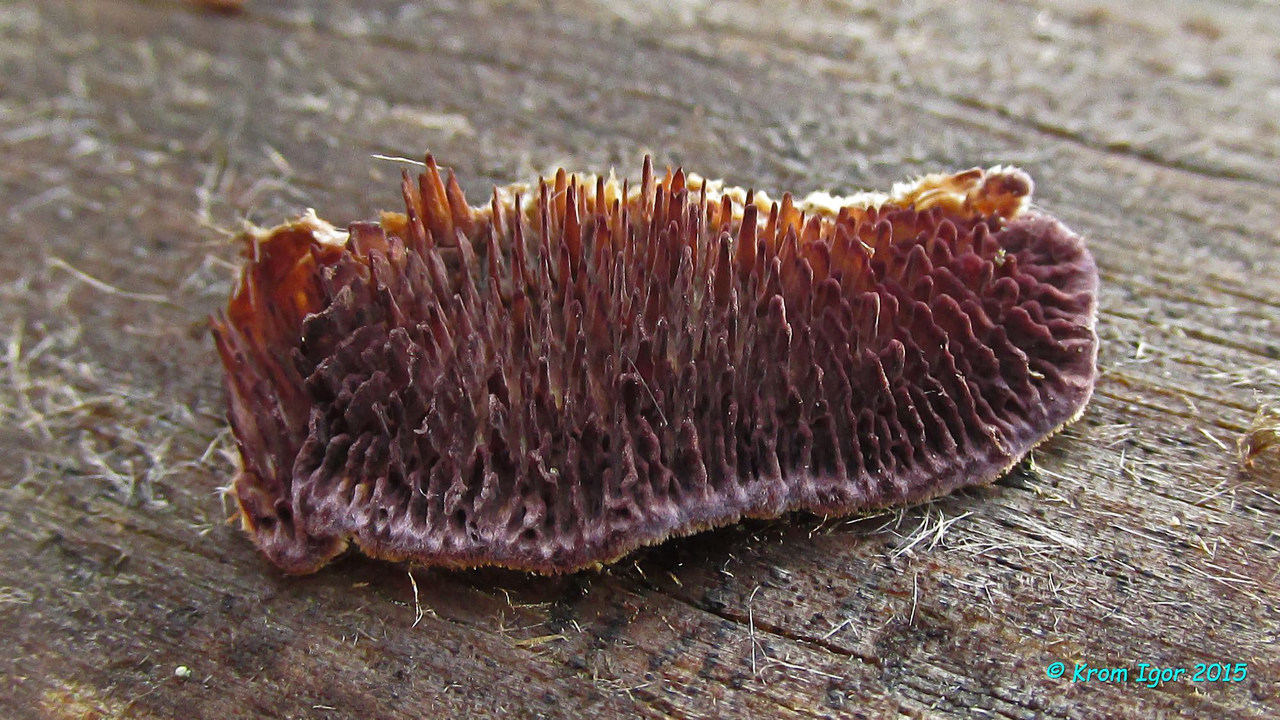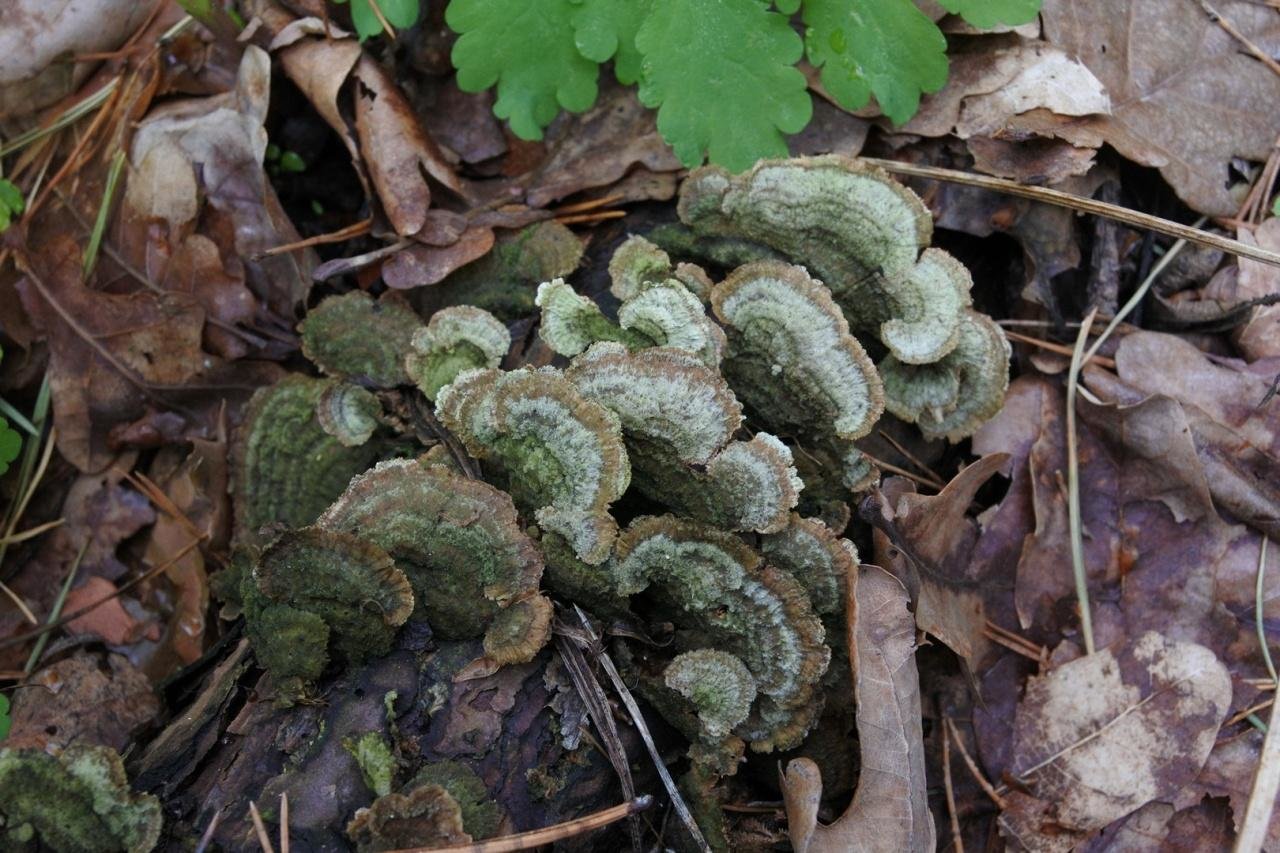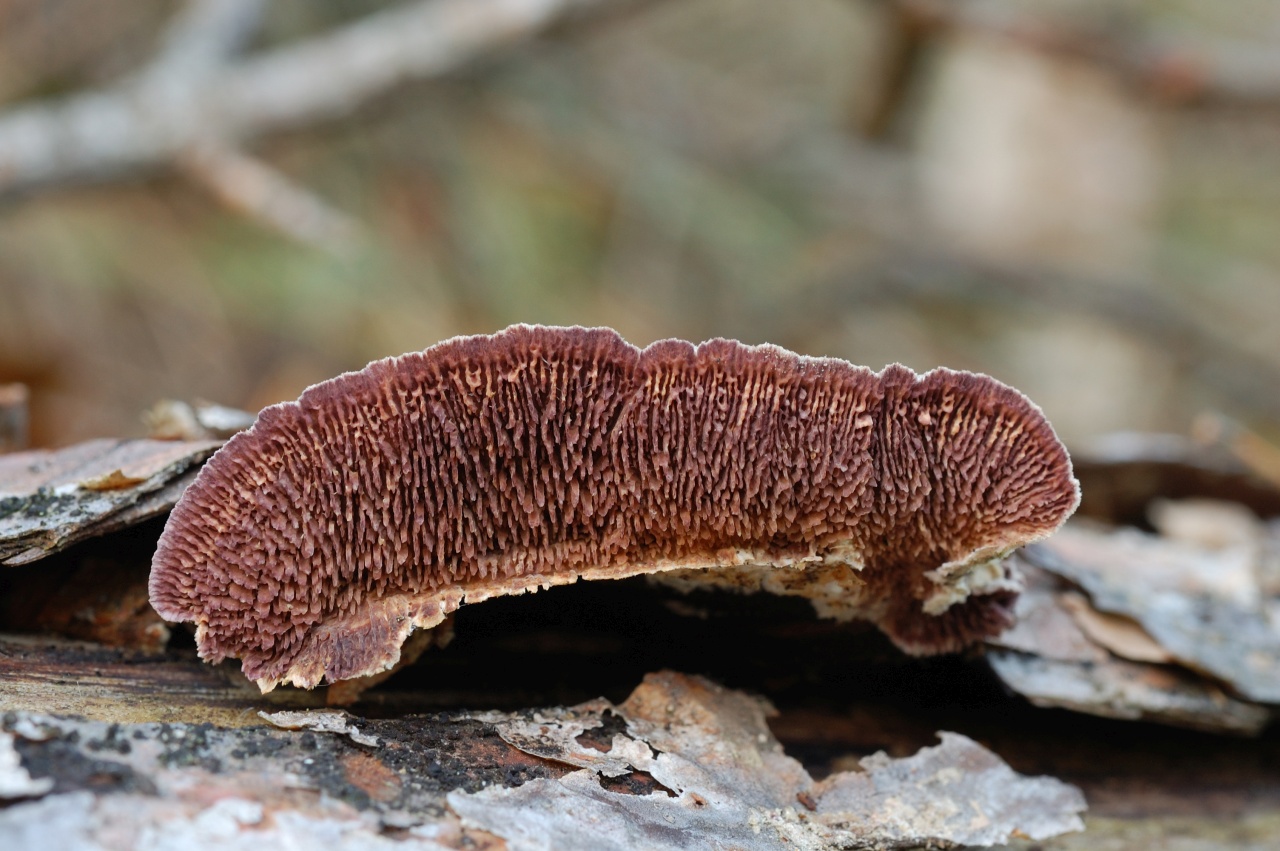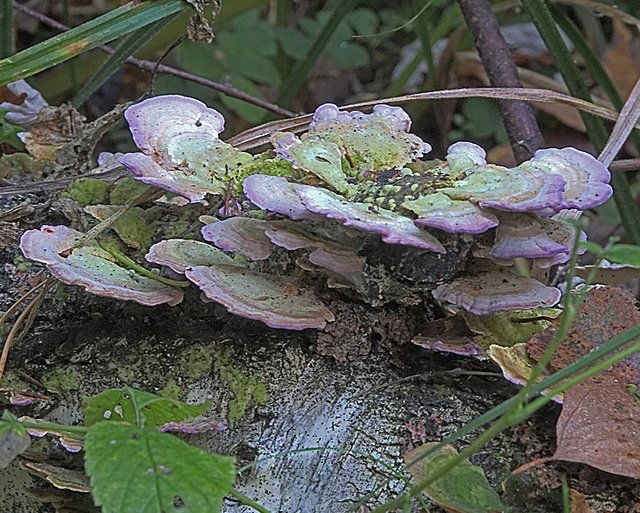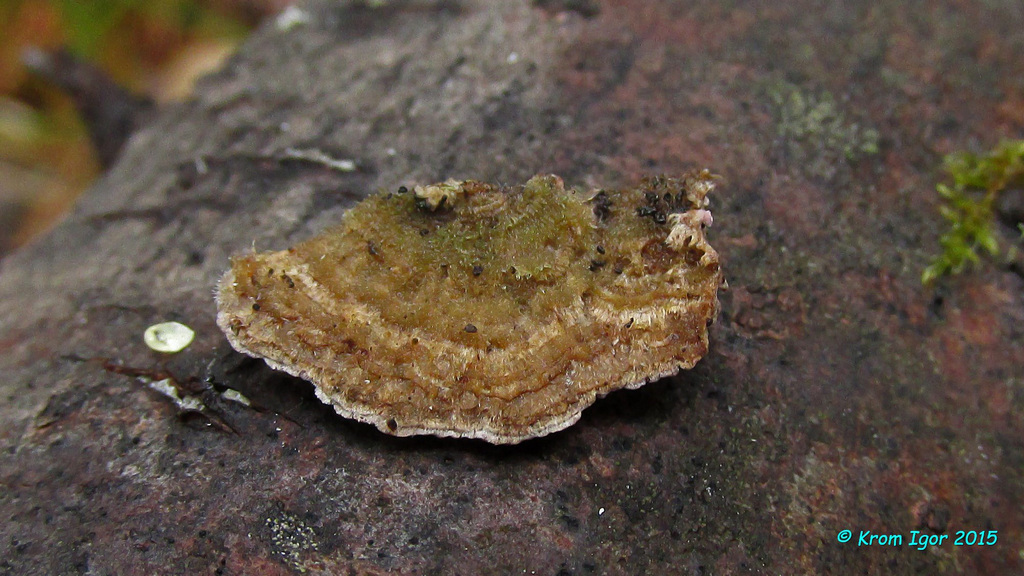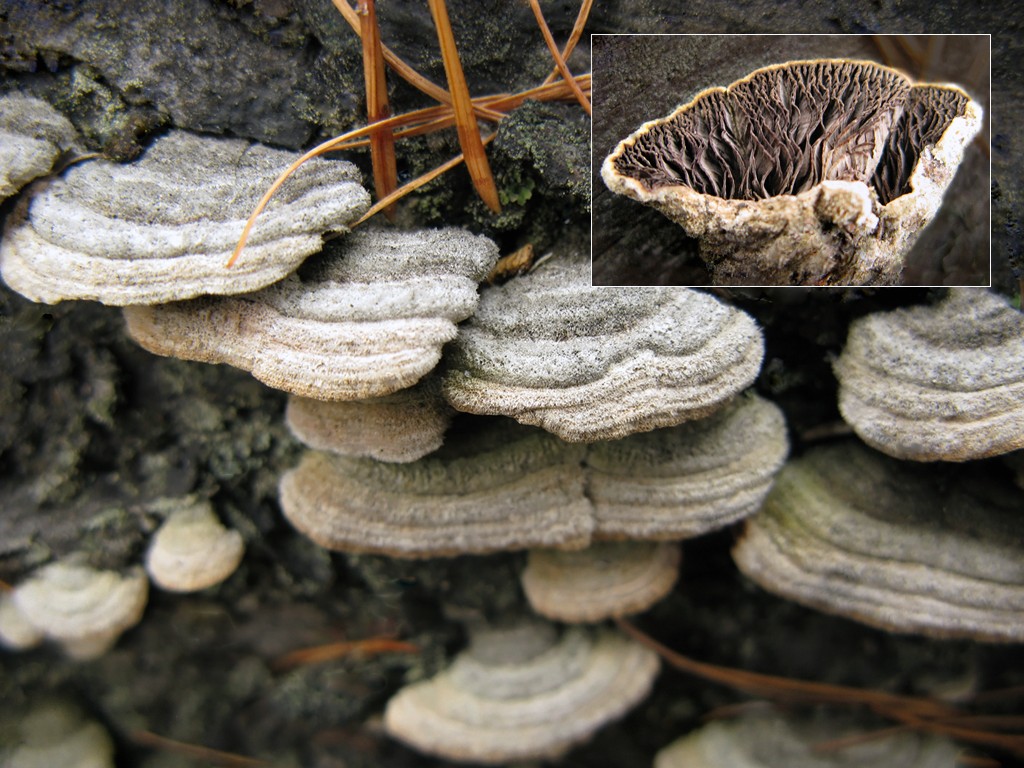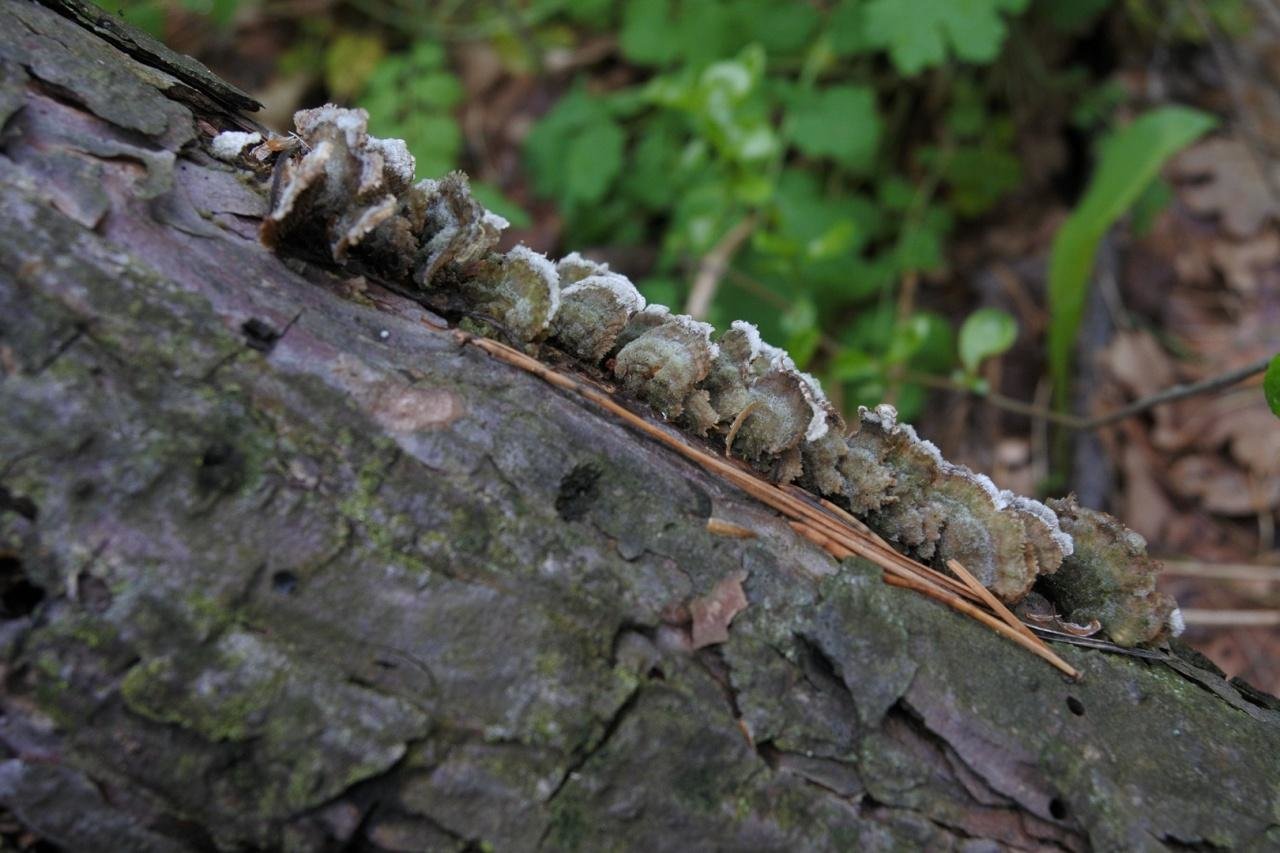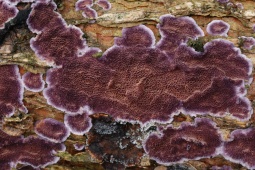Trichaptum brown-violet: photo and description
| Name: | Trichaptum brown-violet |
| Latin name: | Trichaptum fuscoviolaceum |
| Type of: | Inedible |
| Synonyms: | Sistotrema fuscoviolaceum, Hydnum fuscoviolaceum, Sistotrema violaceum var. fuscoviolaceum Irpex fuscoviolaceus, Xylodon fuscoviolaceus, Hirschioporus fuscoviolaceus, Trametes abietina var. fuscoviolacea |
| Systematics: |
|
Trichaptum brown-violet belongs to the Polypore family. The main distinguishing feature of this species is an unusual hymenophore, consisting of radially located plates with jagged edges. This article will help you get to know Trichaptum brown-violet closer, learn about its edibility, places of growth and distinctive features.
What does a brown-violet trichaptum look like?
In some cases, brown-violet trichaptum acquires a greenish tint due to epiphytic algae that have settled on it
The fruiting body is half, sessile, with a tapering or wide base. As a rule, it has a prostrate shape with more or less bent edges. It is not very large. So, the caps are no more than 5 cm in diameter, 1-3 mm in thickness and 1.5 in width. The surface is velvety to the touch, short, grayish-white. The edges of the cap are bent, sharp, thin, in young specimens they are painted in a lilac shade, turn brown with age.
The spores are cylindrical, smooth, slightly pointed and narrowed at one end. Spore white powder. Hymenophore hyphae are characterized as hyaline, thick-walled, weakly branched with a basal buckle. The hyphae trams are thin-walled, the thickness is no more than 4 microns.
On the inside of the cap there are small plates with uneven and brittle edges, which subsequently look like flat teeth. At the initial stage of ripening, the fruit body is colored purple, gradually acquiring brown shades. The maximum fabric thickness is 1mm, and it becomes hard and dry when dry.
Where and how it grows
Trichaptum brown-violet is an annual fungus. It is mainly located in pine forests. Occurs on coniferous wood (pine, fir, spruce). Active fruiting occurs from May to November, but some specimens can exist throughout the year. Prefers a temperate climate. On the Russian territory, this species is located from the European part to the Far East. Also found in Europe, North America and Asia.
Is the mushroom edible or not
Trichaptum brown-violet is inedible. It does not contain any toxic substances, but due to the thin and hard fruiting bodies, it is not suitable for use in food.
Doubles and their differences
Located on wood, trichaptum brown-violet causes white rot
The most similar types of brown-violet trichaptum are the following specimens:
- Larch trichaptum is an annual tinder fungus; in rare cases, two-year-old fruits are found. The main distinguishing feature is the hymenophore, which consists of wide plates. Also, the caps of the twin are painted in a grayish tone and have the shape of a shell. A favorite place is dead larch, which is why it got the corresponding name. Despite this, such a variety can be found on large valezh of other conifers. This twin is considered inedible and is quite rare in Russia.
- Spruce trichaptum is an inedible mushroom that grows in the same area as the species in question. The hat has a semicircular or fan-shaped shape, painted in gray tones with purple edges. The double can be distinguished only by the hymenophore. In spruce, it is tubular with 2 or 3 angular pores, which later resembles blunt teeth.Trichaptum spruce grows exclusively on dead wood, mainly spruce.
-
Trichaptum is twofold - it grows on deciduous wood, prefers birch. It does not occur on coniferous deadwood.
Conclusion
Trichaptum brown-violet is a tinder fungus, which is widespread not only in Russia, but also abroad. Since this species prefers a temperate climate, it grows extremely rarely in tropical regions.
Description
The purple spider web, or sometimes it is called the purple spiderweb, is the adornment of any forest. Despite the fact that it is conditionally edible, it is not recommended to collect it due to its uniqueness. During the mushroom season, it can be found only once. Its number decreases every year.
The mushroom cap can be up to 15 cm in diameter. It can be hemispherical or flat. There is a tubercle in the center. A young mushroom has a purple cap. In rare cases, its color may be red. It can fade over time. In the lower part there are wide plates.
The pulp at the break has a blue tint, and the smell of the mushroom is almost not felt. The pulp is quite fragile, it is easy to break it in your hands.
The stem of the mushroom is long and pleasant to the touch. The same can be said about armor. A thickening can be seen towards the base. During maturation, the stem can become tubular. The outer layer of the fungus is purple in color.
Oligoporus bluish-gray (Postia caesia)
- Other names for the mushroom:
- Postia bluish-gray
- Postia bluish-gray
- Postia gray-blue
Other names:
- Oligoporus bluish gray;
- The postia is bluish-gray;
- The post is gray-blue;
- Bjerkandera caesia;
- Boletus caesius;
- Oligoporus caesius;
- Polyporus caesiocoloratus;
- Polyporus ciliatulus;
- Tyromyces caesius;
- Leptoporus caesius;
- Polyporus caesius;
- Polystictus caesius;
External description
The fruiting bodies of the bluish-gray postia consist of a cap and a leg. The stem is very small, sessile, and the fruit body is half-shaped. Oligoporus bluish-gray is characterized by a wide spreading part, fleshy and soft structure.
The top of the hat is white with small bluish spots in the form of spots. If you press hard on the surface of the fruiting body, then the pulp changes its color to a more intense one. In immature mushrooms, the skin is covered with a bristle edging, but as the mushrooms mature, it becomes bare. The pulp of this type of mushroom is very soft, white in color; under the influence of air it becomes blue, greenish or grayish. The taste of the bluish-gray post is insipid, the pulp is characterized by a barely noticeable aroma.
The hymenophore in the fungus is represented by a tubular type, has a grayish, bluish or white color, which becomes more intense and saturated with mechanical action. The pores are characterized by their angularity and large size, and in mature mushrooms they acquire an irregular shape. The tubules of the hymenophore are long, jagged and very uneven edges. Initially, the color of the tubes is whitish, and then it becomes fawn with a bluish tint. If you press on the surface of the tube, then its color changes, darkens to bluish-gray.
The length of the cap in a bluish-gray post varies within 6 cm, and its width is about 3-4 cm. In such mushrooms, the cap often grows sideways with the stem, has a fan-shaped shape, is covered with visible villi on top, fibrous. The color of the mushroom cap is often grayish-blue-green, sometimes lighter along the edges, having yellowish tints.
Season and habitat of the mushroom
You can meet the bluish-gray posture in the summer and autumn months (from July to November), mainly on the stumps of deciduous and coniferous trees, on tree trunks and dead branches. The fungus is found infrequently, mainly in small groups. You can see the bluish-gray posttia on the dying wood of willow, alder, hazel, beech, fir, spruce and larch.
Edibility
There are no toxic and poisonous substances in the fruiting bodies of the bluish-gray Postia, but this type of mushroom is very tough, so many mushroom pickers say that they are inedible.
Similar types and differences from them
In mushroom growing, there are several closely related varieties with bluish-gray posture, differing in ecology and some microscopic features. For example, Postia bluish-gray has a difference in that the fruiting bodies of the fungus do not turn blue when touched. This mushroom can also be confused with alder post. True, the latter differs in the place of growth, and is found mainly on alder wood.
Other information about the mushroom
The first description for the postia bluish-gray was by Heinrich Adolf Schrader. The scientist made it in 1794, in a group with other mushrooms that have a tubular hymenophore. In 1821, another scientist - E.M. Fries transferred the bluish-gray posture to another genus - tubular tree fungi, narrower in structure. And only in 1881, Peter Adolf Carsten transferred the mushrooms of this species to the genus Postia.
Beneficial features
The webcap contains many vitamins. It is composed of B1 and B2, zinc, copper, manganese. This mushroom is characterized by stearic acid and ergosterol. The medicinal properties of this plant are noted by many pharmacists. Such a conditionally edible mushroom is used in the manufacture of remedies for fungus, antibiotics. It is able to lower glucose levels. It can also be used to create drugs that control hypoglycemia. The cobweb has anti-inflammatory properties, it perfectly supports the activity of the immune system. Due to the large amount of vitamins, it helps to normalize the digestive tract, it also protects the body from infections and prevents overwork, fatigue.
Description
A tree fungus, the thin fruiting bodies of which are located on the substrate in a heap in the form of tiles.
Hat
Reaches 6 cm in diameter, and only 0.3 cm in thickness. The shape of the fruit bodies is approximately semicircular, but with uneven edges. The color is light gray or brownish, with a violet color at the edges. With a prolonged absence of precipitation, the mushroom can fade to almost white. The surface in young specimens is slightly fibrous, in old specimens it is smooth.
Spore-bearing layer
The hymenophore is located on the underside of the cap and is colored crimson purple. Over time, it becomes brownish and then yellowish. The pores of the spore-bearing layer are characterized by unevenness and angularity.
Trichaptum biforme
Current title
| Index Fungorum | Trichaptum biforme (Fr.) Ryvarden | |
| MycoBank | Trichaptum biforme (Fries) Ryvarden |
Systematic position
Etymology of the species epithet
Biformis, e having two images, two-shaped, two-faced. From bis- twice, twice or doubly + -formis, e, species, form.
Synonyms
- Polyporus biformis Fr., in Klotzsch, Linnaea 8: 486 (1833)
- Polystictus biformis (Fr.) Fr., Nova Acta R. Soc. Scient. upsal., Ser. 3 1 (1): 84 (1851)
- Bjerkandera biformis (Fr.) P. Karst., Bidr. Känn. Finl. Nat. Folk 37: 44 (1882)
- Coriolus biformis (Fr.) Pat., Cat. Rais. Pl. Cellul. Tunisie (Paris): 48 (1897)
- Microporus biformis (Fr.) Kuntze, Revis. gen. pl. (Leipzig) 3 (2): 495 (1898)
- Trametes biformis (Fr.) Pilát, in Kavina & Pilát, Atlas Champ. l'Europe, III, Polyporaceae (Praha) 1: 277 (1939)
- Hirschioporus friesii (Klotzsch) D.A. Reid, Contr. Bolus Herb. 7:59 (1975)
- Coriolus prolificans (Fr.) Murrill, N. Amer. Fl. (New York) 9 (1): 27 (1907)
- Trichaptum pargamenum (Fr.) G. Cunn., Bull. N.Z. Dept. Sci. Industr. Res., Pl. Dis. Div. 164: 100 (1965)
- Spongipellis laceratus (Berk.) Pat., Essai Tax. Hyménomyc. (Lons-le-Saunier): 84 (1900)
- Hirschioporus elongatus (Berk.) Teng, Chung-kuo Ti Chen-chun,: 761 (1963)
- Polyporus menandianus Mont., Annls Sci. Nat., Bot., Sér. 2 20: 362 (1843)
- Microporus inquinatus (Lév.) Kuntze, Revis. gen. pl. (Leipzig) 3 (2): 496 (1898)
- Microporus evolvens (Berk.) Kuntze, Revis. gen. pl. (Leipzig) 3 (2): 496 (1898)
- Microporus candicans (Lév.) Kuntze, Revis. gen. pl. (Leipzig) 3 (2): 495 (1898)
- Coriolus sartwellii (Berk. & M. A. Curtis) Murrill, Bull. Torrey bot. Club 32 (12): 646 (1905)
- Polyporus pseudopargamenus Thüm., Mycoth. Univ., Cent. 12: no. 1102 (1878)
- Polystictus hodgkinsoniae (Kalchbr.) Rick, in Rambo (Ed.), Iheringia, Sér. Bot. 7: 246 (1960)
- Polyporus ehretiae Bres., Stud. Trent., Classe II, Sci. Nat. Econ. 7 (1): 56 (1926)
- Polystictus sublimitatus (Murrill) Murrill, Bull. Torrey bot. Club 65: 661 (1938)
Habit
Fruit body: Sedentary, cantilever, hoof-shaped, in the form of an irregular growth or rosette
- Hymenophore: Tubular, porous
- Hymenophore: Thorny
Fruiting body
Fruiting bodies are annual, sessile, prostrate-bent or prostrate, taper towards the base, thin, elastic, leathery; on the side surfaces of tree trunks - fan-shaped, up to 50 mm in diameter and 6 mm thick; are arranged in tiled groups, grow together, form rosettes on the upper surfaces, they may not form lobes on the lower surfaces, forming only a hymenophore layer. The surface is short tomentose, silky, with time it becomes almost naked, with concentric zones. The color changes over time: first lilac, violet, then, starting from the base, turns pale, acquires a light yellow-brown color. Algae and cyanobacteria settle on old fruit bodies, which color the fungi green. The edge is thin, sharp, often lobed, retains its purple color for a long time.
The hymenophore is tubular, the tubules are very short, up to 0.5 mm long, over time they lengthen up to 5 mm, the walls collapse and the hymenophore acquires a prickly, dissected-toothed (irpexoid) appearance. The surface of the hymenophore is lilac or purple, fades over time, in old and dead fruiting bodies it completely fades to a brownish-yellowish color. The pores of young fruit bodies are round or oblong, small - 0.2 - 0.3 mm in diameter, on average 3 - 4 pcs. by 1 mm.
Pulp
The pulp is fibrous-leathery, white or beige.
Microscopy
Spores 6 - 7 × 2 - 2.5 μm, allantoid.
Basidia 12 - 22 × 4 - 5.5 μm, clavate.
Cystids 20 - 35 × 3 - 5 µm, abundant, slightly thick-walled, fusiform, inlaid in the upper part, with a buckle at the base.
The hyphae system is dimitic. Generative hyphae are thin-walled, with buckles, sometimes branched, 2.5 - 7 µm in diameter. Skeletal hyphae are thick-walled, rarely branched, 3 - 6 µm in diameter.
Ecology and distribution
Substance: Woody plants (living trees, bark and dead wood)
Grows on dead and dead, often burnt trunks of deciduous trees, prefers birch (Betula), but also occurs on aspen (Populus tremula), alder (Alnus), rarely on hornbeam (Carpinus), beech (Fagus), oak (Quercus) , noted as an exception in conifers. Causes white rot.
Taxonomy
Trichaptum in two was first described by Elias Magnus Fries in 1833 as a composite genus of hard tree fungi with a tubular hymenophore. Later described by him under several other names. In 1965, for the first time transferred to the genus Trichaptum, since 1972 known by its modern name.
Synonyms
- Bjerkandera biformis (Fr.) P. Karst., 1882
- Coriolus biformis (Fr.) Pat., 1897
- Coriolus elongatus (Berk.) Pat., 1900
- Coriolus friesii (Klotzsch) Pat., 1900
- Coriolus laceratus (Berk.) Pat., 1900
- Coriolus pergamenus (Fr.) G. Cunn., 1950
- Coriolus prolificans (Fr.) Murrill, 1907
- Coriolus sartwellii (Berk. & M.A. Curtis) Murrill, 1905
- Coriolus simulans (Błoński ex Sacc.) P. Karst., 1904
- Coriolus sublimitatus Murrill, 1938
- Heteroporus pergamenus (Fr.) Bondartsev & Singer, 1941
- Hirschioporus elongatus (Berk.) Teng, 1963
- Hirschioporus friesii (Klotzsch) D.A. Reid, 1975
- Hirschioporus pergamenus (Fr.) Bondartsev & Singer, 1941
- Irpex elongatus (Berk.) Lloyd, 1923
- Leucoporus xalapensis (Berk. & M.A. Curtis) Pat., 1903
- Microporellus friesii (Klotzsch) Ryvarden, 1972
- Microporus biformis (Fr.) Kuntze, 1898
- Microporus candicans (Lév.) Kuntze, 1898
- Microporus elongatus (Berk.) Kuntze, 1898
- Microporus evolvens (Berk.) Kuntze, 1898
- Microporus friesii (Klotzsch) Kuntze, 1898
- Microporus inquinatus (Lév.) Kuntze, 1898
- Microporus laceratus (Berk.) Kuntze, 1898
- Microporus pergamenus (Fr.) Kuntze, 1898
- Microporus prolificans (Fr.) Kuntze, 1898
- Microporus sartwellii (Berk. & M.A. Curtis) Kuntze, 1898
- Microporus simulans (Błoński ex Sacc.) Kuntze, 1898
- Microporus xalapensis (Berk. & M.A. Curtis) Kuntze, 1898
- Polyporus biformis Fr., 1833basionym
- Polyporus ehretiae Bres., 1926
- Polyporus elongatus Berk., 1842
- Polyporus evolvens Berk., 1856
- Polyporus friesii Klotzsch, 1833
- Polyporus inquinatus Lév., 1846
- Polyporus laceratus Berk., 1839
- Polyporus menandianus Mont., 1843
- Polyporus pergamenus Fr., 1838
- Polyporus prolificans Fr., 1838
- Polyporus pseudopargamenus Thüm., 1878
- Polyporus sartwellii Berk. & M.A. Curtis, 1872
- Polyporus simulans Błoński, 1889, nom. illeg.
- Polyporus xalapensis Berk. & M.A. Curtis, 1849
- Polystictus biformis (Fr.) Fr., 1851
- Polystictus candicans Lév., 1863
- Polystictus elongatus (Berk.) Fr., 1851
- Polystictus evolvens (Berk.) Cooke, 1886
- Polystictus friesii (Klotzsch) Cooke, 1886
- Polystictus inquinatus (Lév.) Cooke, 1886
- Polystictus laceratus (Berk.) Fr., 1851
- Polystictus pergamenus (Fr.) Cooke, 1886
- Polystictus prolificans (Fr.) Fr., 1851
- Polystictus sartwellii (Berk. & M.A. Curtis) Cooke, 1886
- Polystictus simulans Błoński ex Sacc., 1891
- Polystictus sublimitatus (Murrill) Murrill, 1938
- Polystictus xalapensis (Berk. & M.A. Curtis) Fr., 1851
- Spongipellis laceratus (Berk.) Pat., 1900
- Trametes biformis (Fr.) Pilát, 1939
- Trametes friesii (Klotzsch) G. Cunn., 1965
- Trametes pergamena (Fr.) Kotl. & Pouzar, 1957
- Trichaptum pergamenum (Fr.) G. Cunn., 1965
Fern Eagle
One of the most famous and widespread Ferns on the planet is the Orlyak fern - a beautiful bright plant, it can decorate any corner in the garden, forest or near a pond.
The culture is used in folk medicine - a decoction from the shoots is used to relieve stress, remove radionuclides, eliminate fever, and strengthen the skeleton. The decoction of the roots has an anthelmintic effect, relieves joint aches, and helps with diarrhea.
The main characteristics of the culture:
What does the bracken fern look like? Common bracken is a perennial herb of the Dennstedtiye family. A distinctive feature when describing a fern is frond, shaped like the wings of an eagle with tips curled inward. Usually Orlyak reaches 70 cm in height, but in more favorable climatic conditions (Primorsky Krai) it grows above a meter. The root system is well developed, deeply located, due to which the plant grows quickly, adapts to any climatic features - the roots do not freeze, they are not afraid of drought, rainfall and even fires.
Where does the bracken fern grow? The culture is found in all corners of the globe, except for Antarctica and the desert, and is widespread in Russia: in the middle zone, in Siberia, the Urals, the Far East, and the Primorsky Territory. Habitat - coniferous (pine) and deciduous (birch) forests, as well as edges, hills, water bodies. It grows well on pastures, clearings, abandoned fields.Prefers sandy, light soil, limestone. In some countries, the fern multiplies at such a fast rate that it is fought like a weed.
How to grow Orlyak at home? Fern is a beautiful original plant that can decorate a corner in the house or an alpine slide in the garden. It is unpretentious, adapted to different climatic conditions, undemanding in maintenance. Bracken is able to reproduce by dividing the bush, spores, rhizomes, processes. Spore reproduction is a long and painstaking process, which is rather difficult to implement at home. The best way to grow a crop is to use a dividing bush or plant shoots by the root. In this case, you need to carefully examine what the fern looks like: stem, leaves, root system. They must be resilient, free from stains and damage.
To plant Orlyak in a pot, it is necessary to prepare a sandy substrate, lay out drainage from gravel or bricks on the bottom. The plant is transplanted into the garden in the spring in a shaded place, protected from drafts. Sand, some ash should be added to the soil, small pebbles should be placed on the bottom.
Note! Fern loves moisture, so it needs regular watering and spraying. When pests appear (scale insects, whiteflies, thrips), insecticides are used
It is not worth trimming the crown - the old pagons are replaced with new ones in the spring.
When pests appear (scale insects, whiteflies, thrips), insecticides are used. It is not worth trimming the crown - the old pagons are replaced with new ones in the spring.

